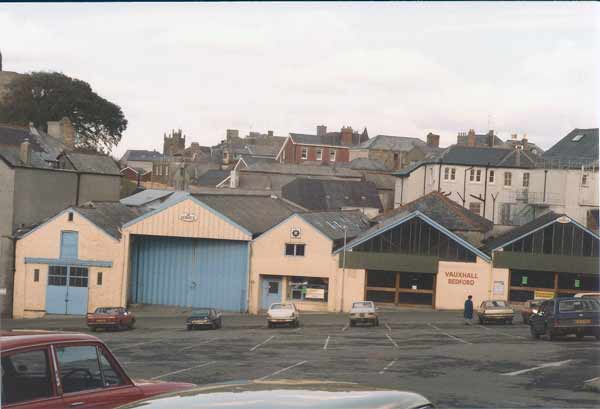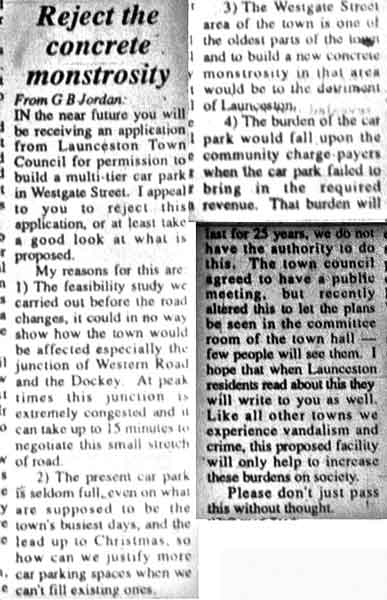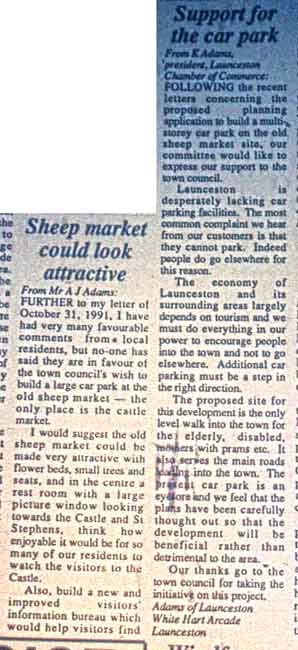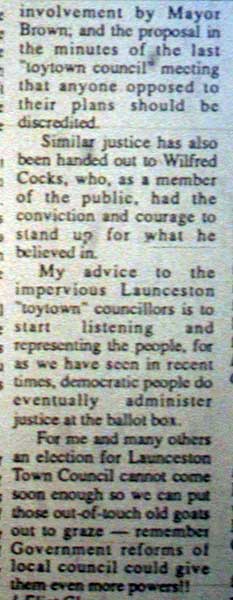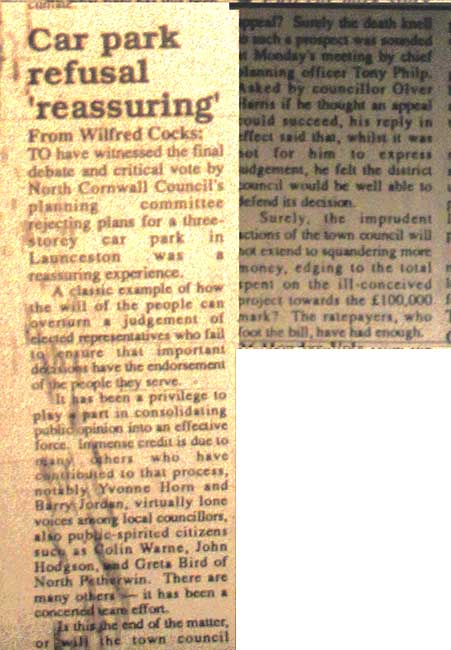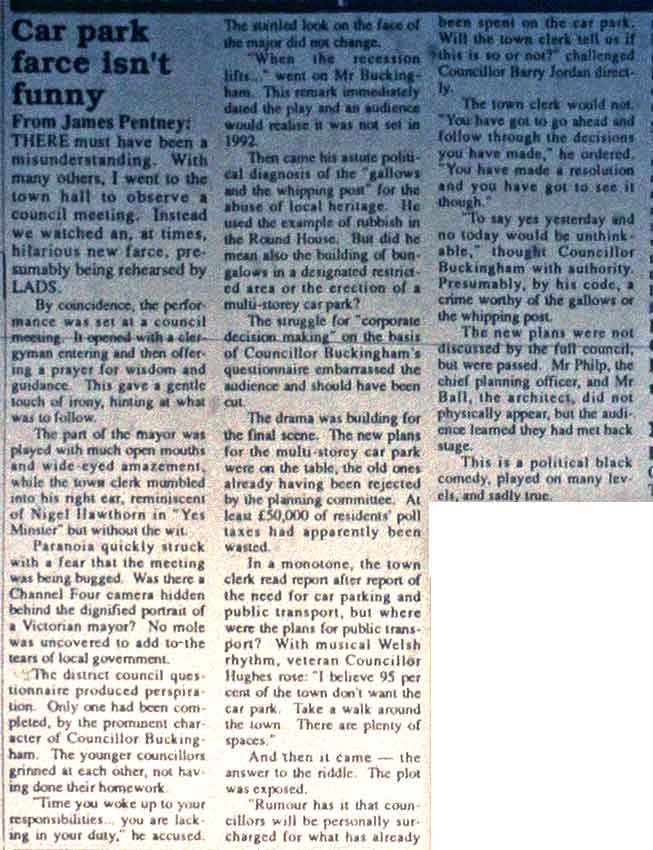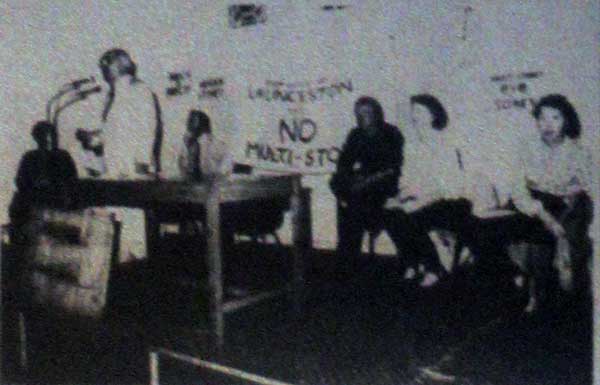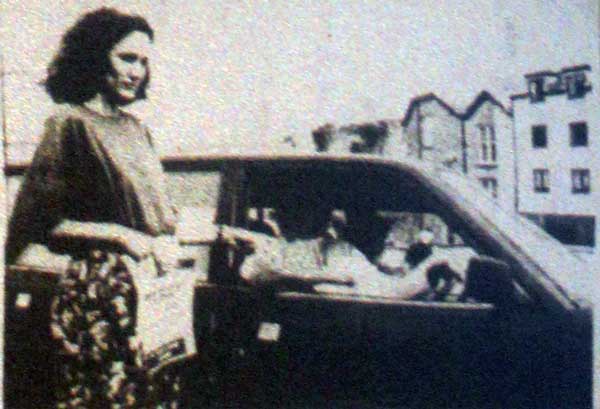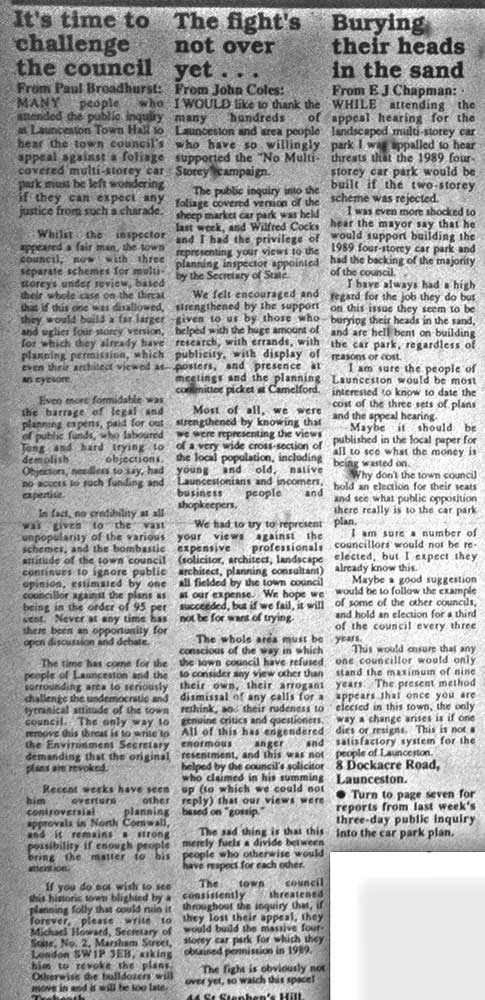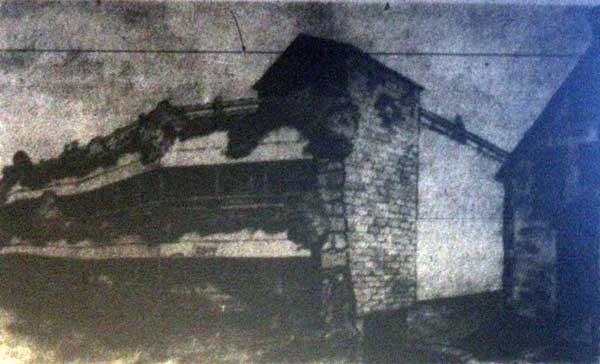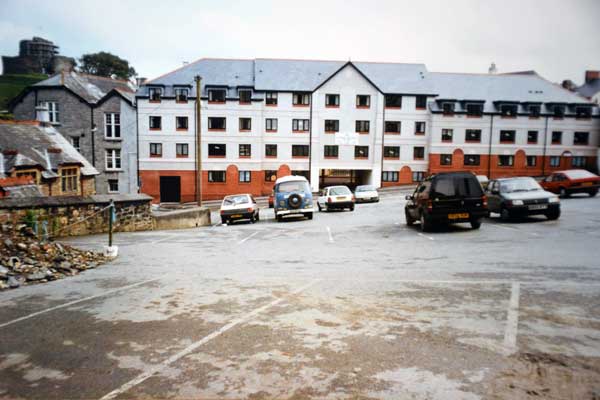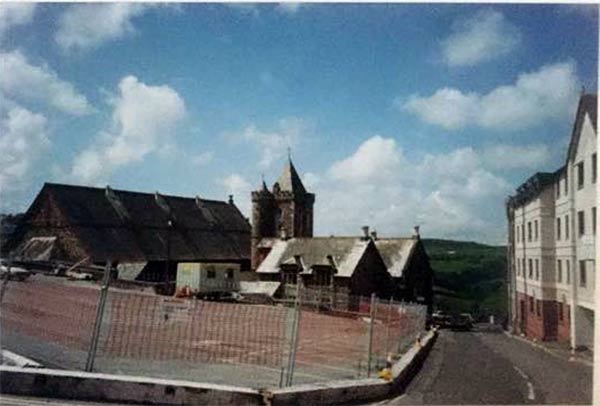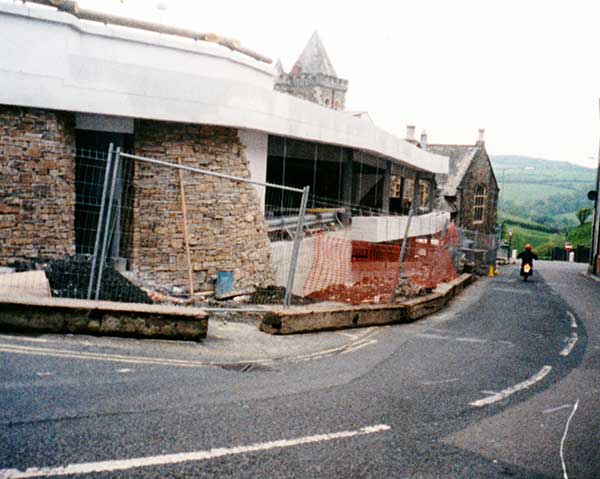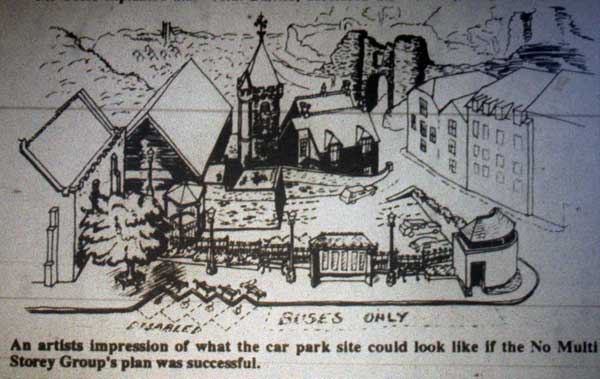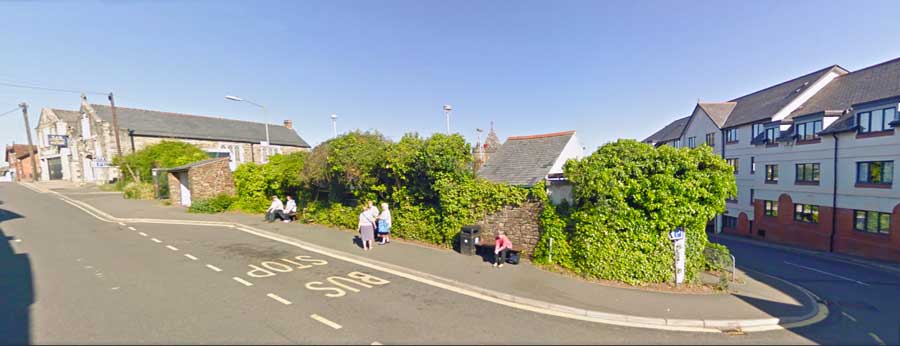.
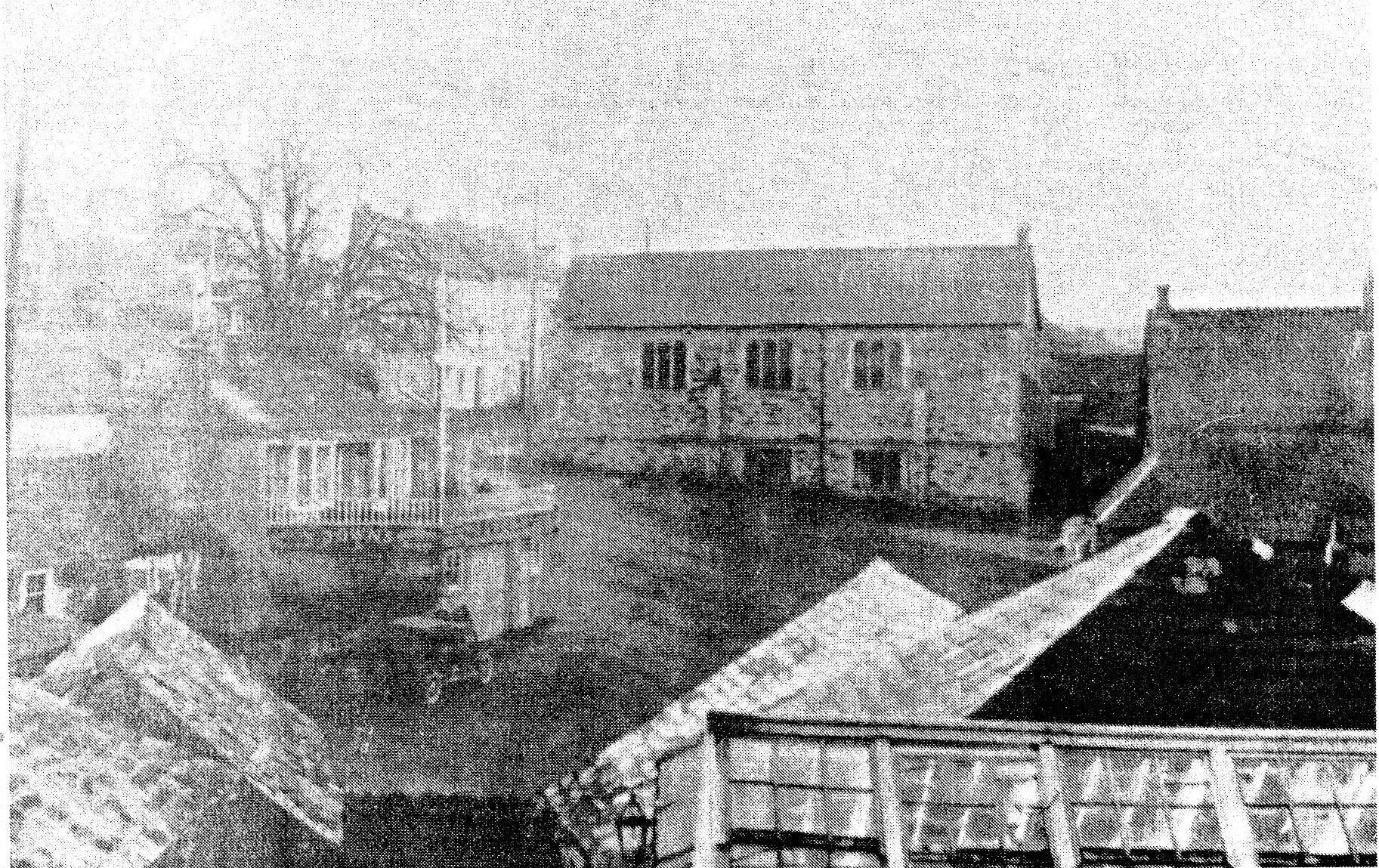
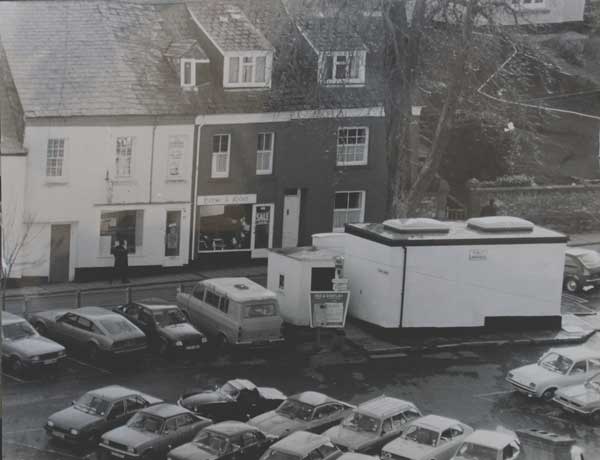
One of the most contentious and divisive of events in Launceston’s recent past is that of the building of the multi-storey car park on the town council’s only car park, known locally as the Old Sheep Market car park which held spaces for up to 75 cars. As the name alludes to, this was once where the market for sheep was held before the construction of the market at Race Hill. Before that, the area was known as Noah’s Ark due to small paddocks located there being used for a menagerie of animals.
The idea for building a multi-storey car park wasn’t a new one, for at the meeting of the town council in January 1939, and with the second world war looming, it was suggested by councillor Sydney Fitze, that a double-decker parking ground embodying an air-raid shelter, accommodating 200 women and children. He suggested that such a scheme would relieve the then parking congestion in the town, incorporating a bus station, whilst also providing work for the towns unemployed. However, it was felt that the cost of adding a bomb-proof shelter would be prohibitive. And so the idea lay dormant for the next 30 years.
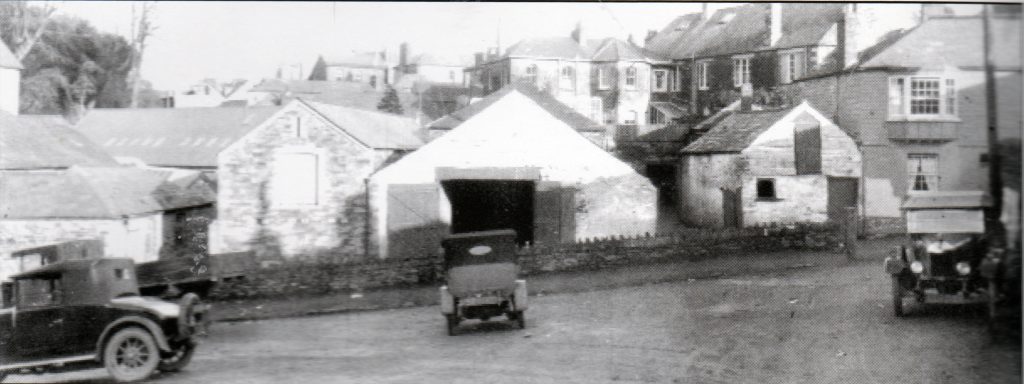
In 1957 three properties (below) positioned on the corner of Westgate Street and the Dockey were purchased and demolished. This was to enable better access down the Dockey whilst also freeing up further car parking spaces although this did little to improve the towns parking issues on the busy market days, although when the redevelopment of the Northgate and Tower Street area in the early 1960’s was finished, there had been three more parking areas were created which did help in alleviating the problem somewhat. The suggestion of building a multi-storey at the Sheep Market was resurrected but after some initial planning it was deemed to expensive.
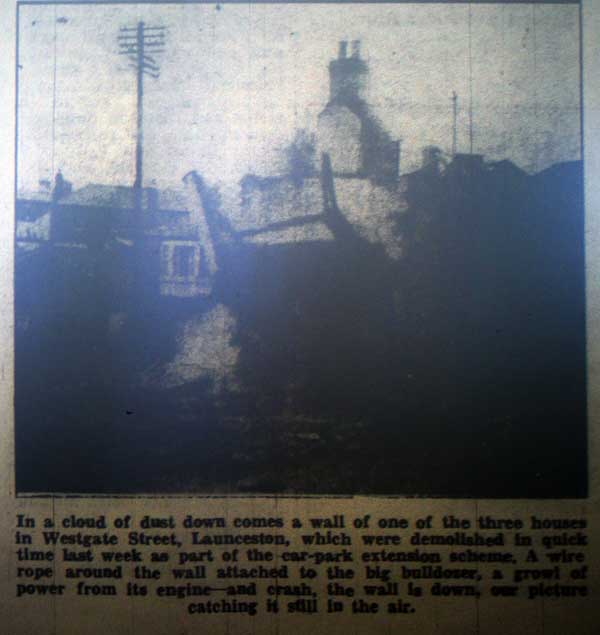
It is not without irony that the impending closure of the Cattle Market in the June of 1991 was to help in resurrecting the idea of the multi-storey. Plans were passed in 1990 but with the country in recession and the very high cost of borrowing at that time, it was shelved as being too costly. However, one move that was to signal the beginning of the discourse, occurred at the beginning of 1991. In January of that year, the town council commissioned a report on the 100 year old horse-chestnut tree that stood by the public toilets on the Westgate Street side of the car park. The county forester concluded that it’s root system had been severely damaged by recent excavations by one of the supply companies, and would either have to be felled or reduced in size. The town clerk, Philip Freestone said ‘the council was disappointed that the tree had to come down, but it was necessary to safeguard lives.’ It was earmarked to be felled in March of that year, however, as Philip Freestone was quoted, “a fly in the ointment” had delayed the act. A separate report commissioned by the ‘Old Cornwall Society’ contradicted the earlier findings by the county forester. The survey by Tavistock Tree Specialists claimed that although three of the main stems of the tree had a number of cavities from the loss of minor branches, and limited decay at the base of the main trunk, it was not enough to make it a danger. The report concluded that the tree was definitely worth retaining, although certain remedial work was necessary to prolong its life. Philip Freestone countered by stating that “ people are taking it as gospel. There are so many experts here who do not accept they are not the real experts.” He continued “We have to go on the report of the county forester who were called in because we had had a report that the tree was on the move.”
The delay in its ultimate fate, was for the council to check its legal situation. In the meantime, great consternation was raised in the letters column of ‘The Cornish and Devon Post.’ Even Joan Rendell lending her support to keeping the tree. A further stay of execution was given at a meeting of the town council finance committee on May 21st with councillor Alan Buckingham saying “I would like to think that if we condemn this tree we have taken the right decision and when we have all the facts I will be willing to make up my mind.” Mayor Derek Bradshaw, told the meeting “that it was not the council’s aim to fell the tree regardless, and stressed that they had no ulterior motive for considering the move.” Muriel Ardley and Joan Rendell, who between them had collected over a 100 signatures presented the committee with their petitions. Also at the meeting was Captain John Hullock who said “that to cut it down without looking at the alternatives would be and act of vandalism.” He concluded that “I do not think that anyone is saying it should be removed at all costs, and if it is sick it will have to be removed, but not until all the facts have been fully established.” It was agreed that a site meeting would be held by the town councillors with district councillors and representatives from the county foresters and Tavistock Tree Specialists in the June. Councillor Rob Tremain, who had been a leading advocate of keeping the tree, said after the finance meeting “that he was amazed by the council’s ‘turnaround’ since the last time the tree’s future was discussed.” He added with what was to be a profound statement for the future, “We have not yet won the day, but I am sure the change is to do with all the publicity it has been getting.” However, despite all the campaigning, at the site meeting it was finally decided that the damage to its roots were such that there was no other course of action left but to fell it, and so at the beginning of September, the tree was removed to much sadness to the people of Launceston. To this day doubts are held as to the reasons and decision to fell the tree, particularly in relation to the building of the multi-storey. But the original plans for the development made provision for the horse -chestnut.
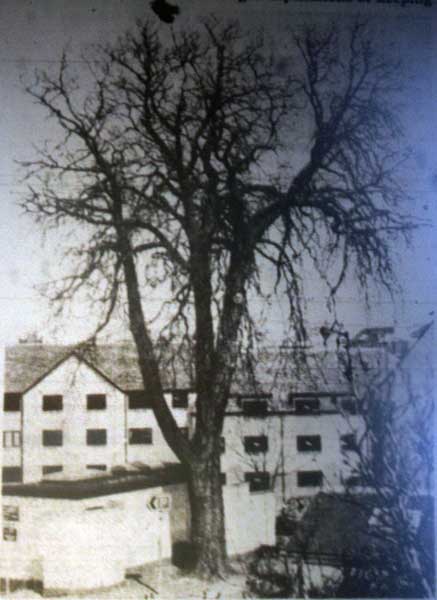
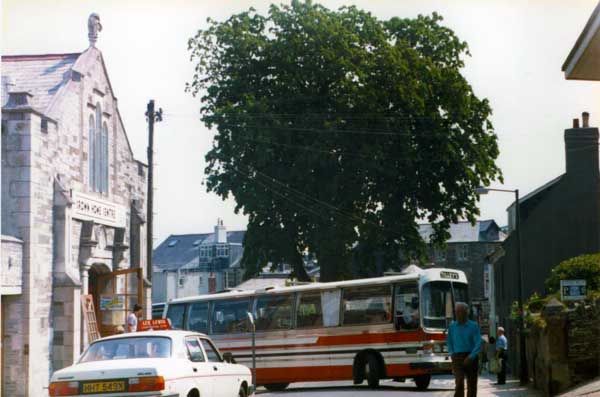
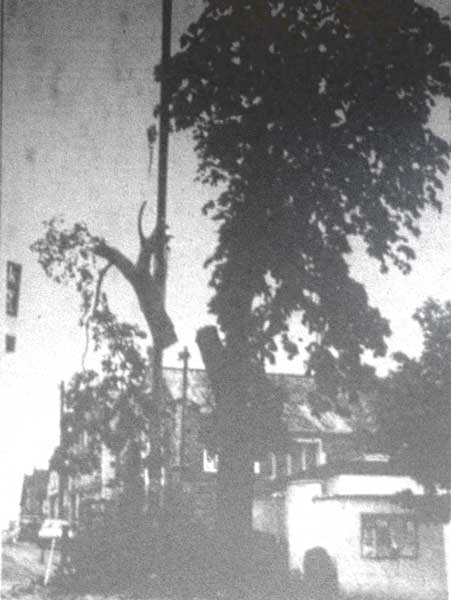
By the time of the horse-chestnuts demise, the closure of the cattle market had taken place and within weeks the district council had contracted work to begin on the removal of the pens. There was much concern as to the district council’s plans for the site, especially the car park which held an extensive amount oft spaces. Rumours were rife that they were keen to sell of the site for development. The local NFU agent at the time, Mr. John Russsell raised the question of the sites future, expressing his concern at the suggested building of a multi-storey car park in which he agreed with the prevailing local opinion that it would be a bureaucratic vandalism of the worst order.
The concerns to the towns car parking arrangements had indeed become one that the town council sought to overcome. The new mayor, Monty Brown, at his inauguration in June 1991, stated these concerns when he said, “I hope that when agreement between the district council and the auctioneers is reached and the site is developed, as it surely will be, our district council will remember, that at present, we have over 250 free parking spaces, which are used in general by people who work in this town, people who are on low incomes, who would find it a struggle if they had to pay district council charges in order to work.” He added that “ we need additional parking to support our small shopkeepers, they are the lifeblood of the town centre.” He said the town council were continuing to look at additional parking capacity on the town hall car park.
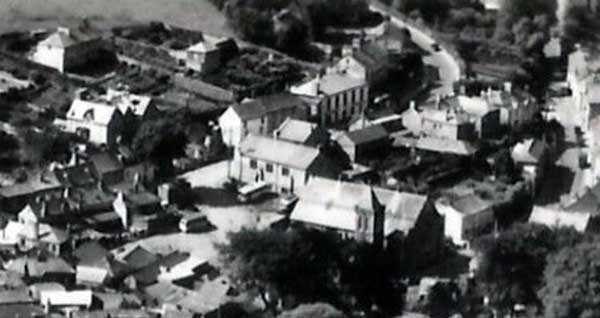
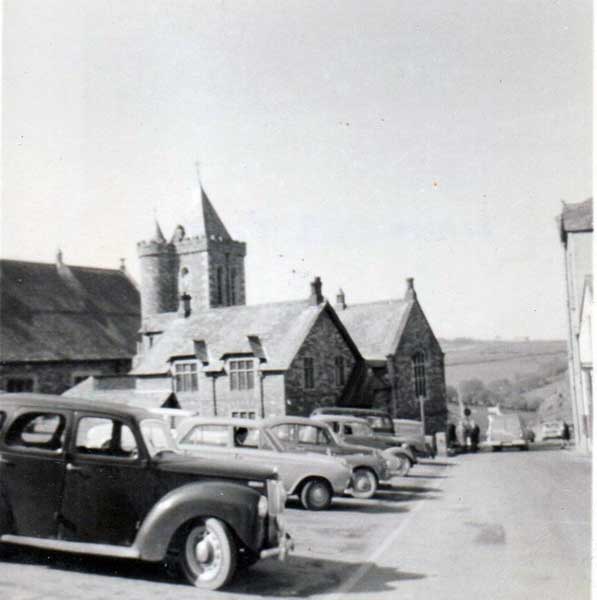
And so the the wheels were set in motion for what was to be the most ever bitterly fought development in Launceston, dwarfing that of the nineteenth century fight to save the Southgate from demolition. As early as the beginning of 1991 top level talks were taking place between the town and district councils. It was felt that some of the £4 million that had been earmarked for a new cattle market at Scarne, Launceston which had been scrapped, could be used towards the new car park.
In September of 1991, the district council treasurer, Harold Chapman, told the councils policy committee that a provision of £800,000 should be allocated to help build a multi-storey car park at Launceston. Planning committee vice-chairman, David Viggers, wondered if this would be enough to cover the costs. In October, the town council invested £100,000 in the Bank of Ireland at a secret session. The cash had amassed through prudent budgeting and through schemes which had been ditched or suspended from the previous year of which £48,000 that had been put aside for the building of the five tier multi-storey in 1990. As the year progressed it became clear that North Cornwall district council planned to turn the market site into a pay and display car park which caused some outrage amongst many from around the town, particularly from the parishes where it was felt that many of the workers who had been able to park free of charge, would now find it difficult to pay the costs whilst earning low wages. It was also pointed out that charging for a car park with such an uneven surface with no clear markings was difficult to justify.
The full plans for the multi-storey were unveiled to the public the week commencing 13th January 1992, and straight away discord was raised with councillor Barry Jordan giving a four point reason as to why the scheme should not get the go ahead (letter to the Cornish and Devon Post below left).

The plans were for a three tier 150 space car-park at a cost of £650,000 which £200,000 had already been set aside for. This was a reduction on the previous five tier scheme which already held permission. Councillor Barry Jordan asked how the town council could justify building a car park of that size when, he claimed, the present car park is seldom used. He said “the burden of the new building, which was a monstrosity, would fall on the rate payers of the town if it failed to bring in the required revenue.” He continued “ the only people who would benefit from this are the traders and there are less now than five years ago the market is now gone and there is nothing to draw people into Launceston so we have to get the town centre growing again and then look at the possibility.” He then accused some members of being on ‘an ego trip’ for resurrecting the proposed car-park which was shelved the previous year after it was deemed financially unviable. “The town clerk is the one who has kept this bubbling, and it is a big feather in his cap if he gets it done,” he said, adding “no one is willing to listen and consider that there is something wrong with what they are proposing.” Fellow councillor Keith Adams, who was also president of the town’s Chamber of Commerce rejected Barry’s claims and said everyone in business in the town was in favour of the plan. He said “the Chamber was ‘thrilled to bits’ with the proposed car park, which he described as ‘a lovely looking’ building.” He continued “when Barry Jordan talks about the car park being empty I don’t know what he is talking about because I never see it empty, and I am getting a little bit tired of knocking Launceston about the car park not being used. Parking is the only thing that people have complained about, and now we are doing something about it he is shouting.” Councillor Adams followed this up with a letter to ‘The Cornish and Devon Post.’
The clash of personalities continued within the council chambers at the next council meeting with councillor Barry Jordan accusing the town clerk, Philip Freestone, of running the council ‘at whim’ after the deposit charges for hiring the town hall were doubled. Councillor Jordan told the meeting Mr. Freestone had adopted a finance committee recommendation to raise the deposits from £25 to £50 without the decision being ratified by the full council. Philip Freestone brushed off the accusations and said it was obvious that the increase would be approved by the full council. He concluded that “it was a unanimous decision and I looked on it as purely administrative.” Councillor Derek Bradshaw supported the town clerks actions as did councillor Alan Buckingham who argued that it was perfectly reasonable for Mr. Freestone to ask for a £50 deposit. Members voted in favour of endorsing the actions of the town clerk with councillor Jordan voting against. It is against this backdrop that Councillor Jordan made an eleventh-hour plea for a public meeting to discuss the proposed development but this was rejected by the rest of the council members. Only long standing member Jim Hughes supported him, and who said “the elderly residents of the retirement flats opposite the site would be faced with a ‘horrible building’ when they looked out of their windows.” Councillor Hughes suggested that Launceston’s residence should be allowed to vote for or against the project before it went ahead. He estimated that 80 per cent would be opposed. However, Councillor Alan Buckingham countered by stating that the car park was part of a scheme for the provision for the future of the town. He said “the council would be ‘criminally neglectful’ to the people of Launceston if the plan did not go ahead. People who look on this car park in isolation have missed the point.” Prophetically he concluded “I would not like to think that the next 60 years in Launceston could not bring us an increase in business to fill the car park.”
The refusal to hold a public meeting caused an quite public furore and the following weeks letter page in ‘The Cornish and Devon Post’ were filled with letters condemning the decision. In one the car park scheme was felt to be ill-judged saying that ‘Launceston town council has always expected its consultative position within the decision making powers of the senior North Cornwall council to be honoured by that council, but themselves deny us any consultation.’ It ended with ‘who is frightened of what?’ Another questions why not put car park to the vote?
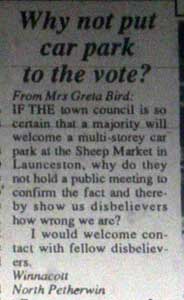
The outcry was such that the town council relented to the pressure and organised a public meeting that took place on Monday February 17th, with over 400 people in attendance. However, the restriction that the council placed at the packed meeting left most of the public feeling that their opinions were not being taken seriously. In a letter from Wilfred Cocks, Sydney Adams, Connie Geach, John Hodgson, Reg Prout, and Colin Warne asked if free speech was under threat? In particular they criticised the mayor, Monty Brown and his dictatorial attitude. They complained of the manner in the way the meeting was set out, especially when the mayor emphasised at the outset that questions only would be permitted, enabling the council to explain its point of view, but forbidding any expression of opinion by the audience. The mayor flat refusal to allow a show of hands to record the feeling of the meeting they felt, reflected a blinkered ‘we know best’ stance, in defiance of natural justice and common sense. The sense of injustice was felt everywhere and helped steel the resolve of those that were against the scheme. A petition set up after the meeting soon had over 1,500 signatories and a momentum against the multi-storey began to gather pace.
A week later there was a claim that an ancient right of way existed running from the top corner by the former Drill Hall down to the opposite corner by the Guildhall, but this could not be proved, even some though early maps did show a track that ran across the site.Further pressure came from a survey conducted by ‘Orbit Housing Developments’ who ran Westgate Mews opposite the Sheep Market. Over the course of one month they had taken readings three times a day, at 10:30 am, 12:30 pm, and 4:30 pm to examine how much the car park was used. Their findings supported councillor Barry Jordan’s earlier claims that the car park was never full. With 56 readings to hand, they confirmed that the car park was full only twice –once on the day of the Spry’s Garage fire, and on another occasion when five coaches were parked there. The only time the site came close to being full was on Tuesdays when coaches each took up several parking spaces. Simon Graham spokesman for Orbit, said “ the motivation to create an eyesore for an unnecessary extra 80 spaces on an already under-utilised site appears odd to say the least.” Yvonne Horn Launceston district councillor was another voice against the scheme. She felt that the car park should remain as it is for a ‘quick turnover’ with longer stay parking at the refurbished cattle market car park. She confirmed North Cornwall district council’s plan to level, resurface and line the first tier of the former cattle market. She admitted that Launceston members of the district council had had two informal meetings with the mayor Monty Brown, and the town clerk, she added that she would never have gone along with the scheme had she known the finances. She said “but we cannot recommend refusal of the plan because of public opinion or the fiances as a planning reason, which is ludicrous. The other slight disadvantage is that they were granted planning permission a couple of years ago for a ‘monstrosity on that site — how it got through I do not know.”
The plan came before the North Cornwall district council planning committee on Monday 14th March, and after much deliberation a move for refusal was defeated by just two votes. Instead a vote of 8-6 was held in favour of a full site meeting. English Heritage in a letter to the meeting said that they greeted the scheme with caution, adding that a building which relies on vegetation for disguise must arouse suspicion. Councillors were split over the proposal — some believed it would desecrate one of the most historic parts of the town, while others argued that Launceston desperately needed additional car parking to cope with tourism and revitalised trade. Yvonne North, repeated her objection labelling it a ‘terrible plan.’ She was supported by the district council’s vice-chairman Ken White who dubbed the plan ‘environmentally unacceptable.’ He said he would like to see the application refused because of the effect it would have on the conservation area and residents in the vicinity. Chief planning officer Tony Philp told members that the council had sought an independent opinion on the ‘rather novel’ landscaping proposed by the town council as part of the scheme. South Petherwin district member Graham Facks-Martin supported the plan, but agreed that a site meeting should be held to discuss it more fully. He also stated that the authority would be on extremely weak grounds if it rejected the application as the town council already had am outstanding permission for a much larger car park on the site. He continued “because the architect has gone to ‘novel lengths’ to landscape it, it is seen to be something to be desired, but I think it should be congratulated.” Concluding he said “Anyone who thinks that Launceston doesn’t need more car parking in the summer must be around the twist.”
It is amazing to consider now, but the clamour for further car-parking spaces in the town was such that there was even a suggestion at this time to sell St. Mary Magdalene Church and churchyard for retail development and a central car park, however this was very quickly dismissed by Rev. Tim Newcombe.
The ante was moved up when the opponents asked the Department of the Environment to investigate the scheme. Wilfred Cocks said a small group of protestors were taking these steps. “The whole situation is being reported with supporting papers to the Department by a small representative group of Launceston residents” he said.
With the debate falling into two entrenched groups, councillor Alan Buckingham suggested that three people from the No group should meet with three members of the council to discuss the situation across the table at an open meeting. He said “a lot of people that came to the public meeting didn’t come to listen to the real facts.” He continued “I’m not afraid to argue the case with anybody. The proposals concerning the car park we have put forward are financially sound.” Councillor Cynthia Buckingham, Alan’s wife, stated that the council would not change people’s minds.
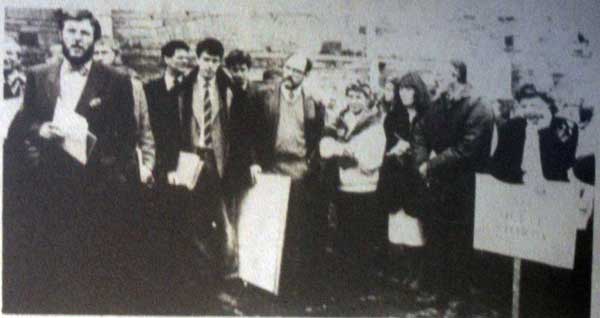
The site meeting was duly held on Thursday March 19th, and as well as the council members and their respective officers, nearly 200 angry residents were in attendance. Launceston mayor Monty Brown described the scheme as a ‘compromise’ of an earlier plan to build a five-storey car park on the site which was given planning by North Cornwall district council in 1989, but was later shelved after it was deemed to costly. He continued by stating that the true cost of the latest proposal would not be known until tenders for the scheme had been received, assuming that planning and loan consent was granted. Robert Harris, an architect with the Jonathon Ball practice of Bude which designed the building, told the meeting they hoped to introduce a certain amount of soft landscaping in the area. The development would enhance and improve the area considerably, he claimed. This was greeted with jeers from the members of the public. Nigel Bowman, director of the Launceston Steam Railway and another prominent opponent of the scheme dubbed it a ‘disaster’ and felt it would terrify tourists away from the town. “I do not think Launceston can afford this classical toy town architecture,” he said. However, town councillor Alan Buckingham dismissed the objections as ‘nonsense’ who said additional car parking was vital for the future of Launceston. He argued that there was no logical planning reason for rejecting the scheme had been put forward and added that it was no good attracting visitors to the town if there were no traders to tend to their needs. “No one can suggest logically that the Cattle Market is an alternative site for car parking in the town — it is absolute nonsense. Anyone who thinks Race Hill is easy access to the town must be an idiot. We want to clear the Square and people must recognise that the provision of this facility is absolutely vital.” Launceston ward members Peter Hockridge and David Viggers both spoke in favour of the plan claiming it was necessary for the future growth of the town. Fellow member Yvonne Horn continued her opposition arguing that residents did not want the proposed car park, and said the site should be left as it is. After lengthy discussion lasting three and half hours a vote was held by the committee with the decision nine to four in recommending the rejection of the application at the next full planning and development committee on April 6th.


Before the full planning committee of North Cornwall district council the application was again debated. In a letter from mayor Monty Brown he stated that the extra car parking was needed in addition to a district council proposal to provide additional cat parking on the site of the town’s old cattle market. Although the estimate for the build had been put at £600,000, the committee heard that tenders opened by town councillors that day were for less than the estimated figure. “One was considerably below that figure,” declared planning committee vice chairman David Viggers. “The larger building firms are falling over themselves to do the job.” Councillor Viggers said the town’s shops were in dire straits and needed the trade a car park would produce. “Please don’t let us down in Launceston. We need the car park very much so that the whole prosperity of the Launceston area can go forward” he pleaded. But councillor Ken White argued that the landscaped car park would be the ‘hanging gardens of Launceston.’ He added “we have got a scheme which will more that make up for this with additional car parking in the cattle market.” Yvonne Horn thought the town council were ‘clutching at straws’ to suggest the car park would help a pedestrianisation scheme for the town. Planning assistant Steve Atkinson said English Heritage felt the site was inappropriate for a car park stating that it was not the answer to Launceston’s problems. Housing committee chairman Graham Facks-Martin claimed English Heritage was ‘standing on its head.” He said it had supported a previous plan for a five-storey car park on the same site which would have had much greater impact on the surrounding area. “The existing car park was 80 per cent full in the winter and over 100 per cent full in summer. It was also not big enough when functions were being held at the town hall or in Launceston town centre” he said. Concluding, councillor Facks-Martin considered the proposed design to have been carefully and sensitively treated. After all the arguments had been heard the application was put to the vote and the proposal was rejected by a majority of twelve votes to eight.
This rejection was felt hard by some with councillor Derek Bradshaw writing a letter to ‘The Western Morning News’ saying that the council were disgusted by the way opposition was raised, claiming that the the project was stopped due to ‘little Hitlers.’ The celebrations of the objectors was short lived however, with town clerk, Philip Freestone within days confirming that the town council would be appealing the decision to the Environment Secretary Michael Howard. In the meantime at the next town council meeting the members were told that the lowest tender to build the car park was some £130,000 less than the estimate and members agreed to call in the two lowest tenders for checking if they were to win their appeal. Philip Freestone told members that the time was ripe for building, and added “Builders want the work so badly they are tendering very low.” He concluded that with the grant from North Cornwall district council, the council would only need to raise £318,000 which would not need loan consent.
The reaction to the town council’s decision to appeal brought a unified response from many who were objecting to the scheme. Greta Bird stating that it was a sad omen that on more than one occasion town councillors who are in favour of the proposed car park have behaved in a very ‘anti’ fashion towards friends and acquaintances they had associated with in harmony for many years. A regular visitor to the town, Professor Dennis Hardy of Brentwood, Essex said “Launceston is a town of rare charm, retaining its distinctive character at a time when all too many towns elsewhere are losing theirs.” He felt that local residents were fully justified in opposing “the monstrous plan for a structure that will destroy for all time this delightful part of the town.” He continued “To read that the town clerk and councillors are persisting with the plan, in the face of public opposition , says much for their sense of public responsibility.” Wilfred Cocks labelled the council as being out of sequence stating that the opposers would reserve their comments until the appeal, unless “of course the council at least comes to terms with the wishes of the public and cancel further action.”
At the town council annual meeting the ongoing multi-storey car park took centre stage. Councillor Alan Buckingham said that the members decided to follow it through to ‘the bitter end’ after it was rejected by planners. “The matter was not final when the district council refused it — that was only stage one,” he said. “Stage two is to appeal — we are not doing this just to be difficult, it would be negligent of this town council not to take it to its logical conclusion for the sake of the people who agree with it.” He was supported by fellow member John Barnes who said Launceston was ‘flooded’ with visitors in the summer, and claimed tourism would be lost if the car park was not built. He argued that of the former cattle market site was developed for retail use, up to 100 current parking spaces could be lost. But objectors were determined to have their say urging the council members to carry out a referendum to gauge opinion. One resident, John Coles, asked why poll tax payers money was being spent on pursuing the controversial scheme in view of the outspoken opposition. He continued “I was surprised that in the face of such strong and outspoken opposition from a quiet and well-mannered town, that the town council is so apparently in such a blinkered way that it wants to push ahead with this idea.” Concluding he said “My point of view might not be that I am against the car park, but I want you to justify building it.”
In the May councillor Derek Bradshaw was elected mayor. He had previously served in the role from 1989 to 1991. In his acceptance speech he said “I still support the decisions of this council and the need for the town hall complex, the car park, town hall improvements, balcony, seating, and provision of more facilities to which we are committed.” He stated that there was hard work ahead for the council, a fact that was not always appreciated. “It is easier or less demanding to be a part-time critic than to give time and effort to serve. The opportunity was there last May but was ignored.” He said.
By mid July new designs had been drawn up by the town council and presented to the councils planning and housing committee, but protesters who had turned up branded the scheme as ‘a folly and a monstrosity.’ Committee chairman Rob Tremain, said “Some councillors who are not on this committee would have liked to look at and discuss this scheme, and I think the plans before us should be referred to the full council.” Some councillors hoped that this latest design would be approved by North Cornwall district council in August — their appeal against the original refusal would then be dropped. In a meeting with North Cornwall district councils planning director Tony Philp, councillor Monty Brown and town clerk Philip Freestone were told that if the design is satisfactory he would recommend it for approval. In the new design the roof line was around ten feet higher than the application refused in April, and the ‘landscaping’ trees and shrubs on the original plans had been removed. The building would be red in colour and hung with natural slate.
This new design did little to quell the opposition with author Paul Broadhhurst stating “This structure would encourage vandalism, put tourist off and do our town a great injustice. Wilfred Cocks asked that this being a new application there should be a new public meeting. He said “the council thinks that altering the cladding will overcome the objections, but the main objection is to the location of the thing itself. We want the whole scheme withdrawn.” The following weeks letter column of ‘The Cornish and Devon Post’ was filled with objecting correspondence.
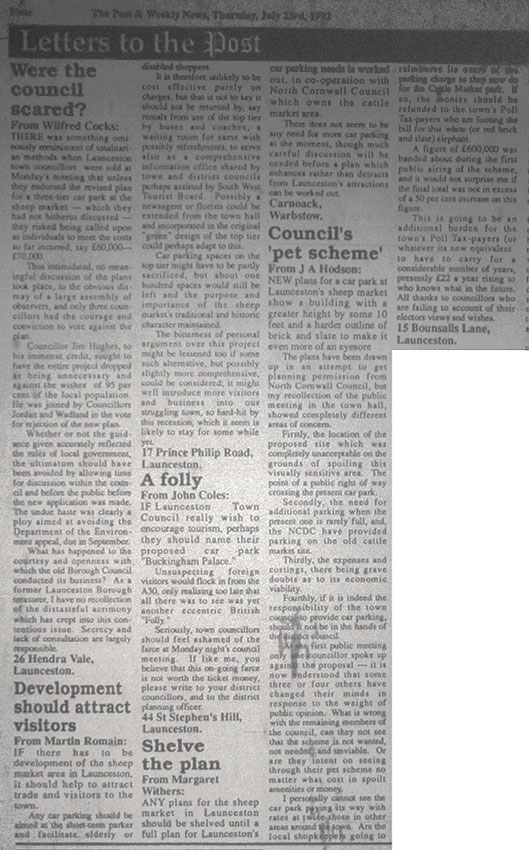


The full council met on Monday July 20th at which after studying the new plan, agreed to putting it forward in a new application. The approval came despite calls from some councillors who believed the scheme should be shelved because of the extent of public opposition. Jim Hughes told the meeting, which was attended by about 50 members of the public, that at least 95 per cent of people in Launceston were opposed to the plan. “Take a walk around the town and see whether the car parks are full, half full, or empty,” he said. “Has anyone gone to the car park in the last month and failed to get a space? There was also a claim by Barry Jordan that several councillors had had a change of mind about the scheme, and wished to oppose it, but were afraid of being surcharged in the following year’s audit. He told the meeting that he would like the plan withdrawn until the appeal was heard. Town clerk, Philip Freestone was unable to confirm whether or not councillors would be liable to individual. “A lot of money would be wasted unless the scheme was carried through to its logical conclusion.” Councillor Alan Buckingham dismissed the concerns adding “the only issue was whether or not members agreed with the plan.” The vote in favour which was carried by a small majority, was widely lambasted by residents with John Coles describing the revised plan as ‘totally unsuitable’ and that Westgate Street would be ‘completely marred.’ The following weeks letters column of ‘The Cornish and Devon Post’ was almost completely taken over with correspondence from various quarters of the area, all rallying against the scheme. One letter labelled the meeting a farce claiming he felt the meeting resembled a rehearsal by Launceston Amateur Dramatics (below).
The decision of the meeting galvanised the objectors, and a demonstration was held in the town square on Saturday August 22nd, just two days before the new application went before the North Cornwall district council planning committee. However, the weather did not co-operate forcing the rally of nearly 300 to the Central Methodist Church school room. Wilfred Cocks (below left), Greta Bird, Jane Broadhurst, Yvonne Horn and Nigel Bowman all spoke at the packed meeting. A collection at the end raised £220 for the Car Park Action Group’s ‘fighting fund.’
Nearly 90 protesters wielding placards and posters chanted at planners as they arrived for the planning meeting, before cramming into the council chamber where they waited for about six hors for the application to be discussed. The meeting heard that the latest scheme, which was recommended for approval by planning officers, was opposed by English Heritage which claimed the proposed development would have an ‘undesirable impact’ on the balance of open space in the town. Altarnun member Ken White described the building as ‘an eyesore’ which was unwanted by many people, and not needed by anyone. He claimed that all that was needed was for better sign posting to the other car parks in the town. Bude member Brenda Parsons said that the multi-storey car park should not be forced on the people of Launceston. Launceston member Peter Hockridge urged councillors to look to the future of the town and approve the plan. He dismissed as ‘pie in the sky’ claims that the town boasted sufficient car parking spaces and warned members that Launceston was in danger of becoming a retirement area. “I feel that a lot of people are deeply concerned with the car park with regards to the poll tax and I can understand that in these days when money is tight,” he said. “The level of car ownership in Launceston is greatly above the national average because of poor public transport and dispersed areas of population. It is important for the future of the town that we should look ahead.” He concluded, “lets keep the centre of Launceston living, and not a retirement area.” After nearly an hour of debate the members voted nine to seven to reject the application. The application was then due to go before the full council on October 5th.
With feelings running high on the matter, the situation took a turn for the worse when an altercation took place between the town clerk Philip Freestone and protester Jane Broadhurst (above right seen handing out stickers at the Sheep Market). Jane had been handing out anti multi-storey stickers by the ticket machine in the Old Sheep Market, when she was told to leave by Philip Freestone. The town clerk then went over to the public notice board and ripped down a poster objecting to the scheme. “I was just standing there handing out these things, asking people if they would like one,” said Jane Broadhurst. “Out came the town clerk and said you are not allowed to stand on council property and do that.” This came after an earlier incident, also involving the town clerk which led cafe owner Frank Conyers complaining to North Cornwall M.P. Paul Tyler. Frank who owned the ‘Cornish Kitchen’ in Westgate Street, was furious when Philip Freestone walked in to the cafe and asked why he was displaying ‘No Multi-Storey’ posters in his window? Frank replied that he was worried that the building of the car park could put him out of business. “The work will take months, and with no coaches parking outside, it will severely damage my trade” he said. “I was very annoyed about Mr. Freestone’s approach.” Philip Freestone stated that on both occasions he had been polite. He said of the incident with Jane Broadhurst “I politely asked Mrs. Broadhurst if should would mind handing out the leaflets for the pavement rather than for the car park, which is private and belongs to the town council.” He added “I took down a poster from the public notice board which was provided by the council and is on council property.”
A formal notice by the Department of the Environment was sent out on August 18th, stating that a public inquiry into the appeal would be held in mid September.
Not every resident were opposed to the multi-story as a letter appearing in late August confirmed. The correspondent stated that the car park protestors were ‘out of touch.’ He said “Launceston needs to attract the custom of people living beyond its boundaries if it is to prosper and provide the facilities for trade and recreation in the future.” “Other towns have adapted to the needs of today’s shopper, the advocates against the car park project appear to be out of touch with these needs. Sadly, the failure to have these plans approved will make it more difficult to attract new business in the future.” He concluded with “Let us hope that common sense will prevail.”
The Public Inquiry
The public meeting was duly held over three days with both supporters and objectors airing their views. The Inspector was Mr. Roger Buss a chartered town planner and architect. The designer of the building, Bude based architect Jonathan Ball, told the first day of the inquiry that the structure would be fronted with natural stone , rough cat render, slate, and sawn timber, which would create a framework on which the proposed landscaping of trees and shrubs would thrive. Although the landscaping would be developed in troughs, Jonathon was keen to stress that it would form part of the actual structure of the car park. “I believe the wood will create the concept of man and nature in harmony,” he said. “Our aim had been to preserve and enhance the area, and soften the impact of a car park whilst restoring the impression of an urban square. Whilst accepting that development in the sheep market area will affect the conservation area, I believe it will enhance it and allow the area to remain alive and prosper.”
Landscape architect Mark Gregory, who was commissioned by the Jonathan Ball Practice to come up with a suitable landscaping scheme for the building, told the inquiry that £5,000 would be set aside each year for maintenance of the foliage. He said that the landscaping had not been included to disguise the building, but to soften its appearance.
Launceston district councillor and businessman David Viggars, supporting the scheme told the inquiry that he saw the erection of a multi-storey at Westgate Street as part of a mooted pedestrianisation of the town centre. Adequate parking was needed on both sides of the town, as many people didn’t want to carry their shopping up Race Hill to the Cattle Market car park. Launceston town councillors Monty Brown, Alan Buckingham, Fran Casely, Derek Bradshaw. And John Barnes also attended the inquiry to speak in favour of the scheme, as did several traders from the town. Alan Buckingham said he had tried to be sympathetic to the objectors concerns, but found it impossible to appreciate ‘their aversion towards greenery.’ “People don’t sit and look at tarmac, they go and find somewhere where there is a bot of greener,” he said.
North Cornwall district council’s solicitor Sally Lloyd-Jones said the authority objected to the plan on design grounds, and had no objection to the principle of a multi-storey car park on the site.
Opponents to the plan, also refused to be swayed, arguing that the proposed building would attract vandalism, cause noise pollution, and exacerbate already serious traffic problems on Westgate Street and the Dockey. Nigel Bowman, said the open structure would encourage vandalism and scare away tourists. The proposed building he said, was not appropriate for the Westgate Street area, which lies adjacent to the town’s historic Castle. “To build such a building opposite flats occupied by elderly people is, at the very least, unreasonable, and, I think, a wicked thing to do,” he said. “The design of the proposed car park is unsuitable because of the open and unrestricted layout envisaged,” he concluded.
The scheme was opposed by English Heritage, which contested that conservation areas were not places in which to experiment.
The inquiry was told that if its appeal was refused that the town council would likely proceed with its approved plan for a four storey 237 space car park on the site. The town council’s counsel, Mr. Robin Midgley, told the inquiry that members were appealing against a decision to reject plans for the 143 space car park which boasted extensive external landscaping of plants, shrubs and timber. The Inspector, he said, had to evaluate the consequences of rejecting the appeal, and to question which of the two schemes was to be preferred. “The existence of planning permission which is likely to be implemented if this scheme is not approved must be a principal material consideration,” Mr. Midgley told the Inspector. Mr. Midgley said the council had pursued the three-storey application as it would be cheaper than the approved plan. But he said that the four-storey scheme would now prove less expensive to build than originally estimated, because of the recession, and was therefore considered feasible. He continued “It is clear that the surge of opposition which is simulated by gossip about costs and by a head in the sand attitude towards the approved scheme has been generated quite recently. It is strange that the people concerned about cost should be doing the worst possible thing and pushing the pursue of the 1989 scheme. The height and mass of the earlier scheme may persuade you that the current scheme is to be preferred.”
The Inspector wound up the inquiry but before leaving Launceston to deliberate his decision, Roger Budge visited the site so that he could see for himself what effect the proposed building would have on the surrounding area.
The Aftermath
Opponents of the plan were aghast at the implication made by Roger Midgley during the inquiry with the ‘No group’ accusing the town council of trying to ‘blackmail’ them into submission and eventual acceptance of the appeal scheme. Paul Broadhurst was one of a number of protestors who called for the 1989 approval to be revoked to prevent it being used as a threat against them. He said after the inquiry, “I have watched with continued amazement at the bulldozer tactics of a small number of intransigent councillors who appear to have nothing but contempt for public opinion.” H e added “The fact that there are three separate applications currently under review demonstrates their bitter determination to realise their vision, no matter what the cost in material or aesthetic terms. The last thing Launceston needs is an urban folly of grandiose proportions that could ruin the town, be and unspecified drain on resources for many years to come, and is loathed by both local and visitors alike.” Again the letters column of ‘The Cornish and Devon Post’ lit up with correspondence.
In the meantime the town council continued with its plan to raise the funds for the construction by applying for credit approval of £350,000 from the National Association of Local Councils. The council needed this approval before it could borrow the funds needed. Town clerk Philip Freestone said the council already had credit approved for 1992, but decided to put in an application for the next financial year in case the car park saga ‘dragged on.’
Further dispute came the following week after John Coles of the ‘No Multi-Storey Group’ stated that the Inspector had been mislead as the the proposed buildings height. He said that when the Inspector had visited the site the town council had fixed a piece of string onto the Guildhall to show the finished height of the car park, whilst the Action Group erected a pole which came out a lot higher. John said “our height was disputed by the council. However, we have since measured the Guildhall, and we believe that the car park will be more than three feet higher than the Inspector was led to believe,” The drawings, illustrating how the difference would affect neighbouring buildings. Mayor Derek Bradshaw, stated that he was confident that the councils measurements were correct had felt that Mr. Coles had made the ‘elementary error’ of checking the height from the existing ground level, rather than the would be ground level if the car park was built. The mayor stated that he was more than confident that drawings by a trained architect would be more accurate than those given by a layman. John Coles, in wishing to clarify how the council arrived at its measurement, visited the town hall to see the plans, but the town clerk Philip Freestone refused to let his see the plans. Derek Bradshaw defended the town clerk stating that Mr. Coles had had ample opportunity in the past to survey the plans. However, this controversy took a sudden turn when at the next council meeting, the town clerk Philip Freestone conceded that the height shown by the piece of string was one metre lower than it should have been. The mistake, he said had occurred as a result of an inaccuracy of an earlier survey of the Guildhall. He added: “There was no intention on our part to show the line incorrectly; it was an error. It was unfortunate that I was not available to the site inspection because I would have realised the plan of the Guildhall was an error.” He continued “the string would have been placed about one metre lower that it should have been.” On hearing of the councils findings, John Coles said he felt ‘vindicated,’ but was surprised not to have received a letter of apology from the authority.
The public inquiry result
It took the Inspector, Roger Buss, two months before he came to his conclusion and he decided to overturn the district council’s refusal and allow the scheme to go ahead. In coming to the decision he said, “the car park would preserve the character and appearance of the conservation area and preserve the setting of listed buildings.” The development, he added, would not have a ‘significant harmful effect’ on nearby properties such as Westgate Mews and the Westgate Inn. He said, “The proposed structure would, if carried out as intended, compliment, rather than imitate, and harmonise with the character of the surrounding buildings and improve the Sheep Market site.” He pointed out that the proposals were in line with the district council’s planning guidelines, encouraging increased parking provision in Launceston. However, permission was granted with several conditions. The town council must start the scheme within five years and no development could take place on the site until a programme of archaeological work had been approved by North Cornwall planners. Planting proposals to landscape the structure would also have to be approved, as would the maintenance of the foliage.
Launceston town clerk Philip Freestone said the town council, which had been roundly criticised for pressing ahead with the scheme, was vindicated by going to appeal. The Department of the Environment’s permission will now go to the next meeting of the full council which will decide if it wants to go ahead with the scheme. Philip Freestone said in an un-conciliatory way: “it’s good news for Launceston as a whole. I don’t know what all the fuss was about originally as I feel the scheme will enhance this area of the town. We still have to make a resolution to build the car park, and that will not be made until the next meeting of the full council.” He said that work could start soon as the finance had been agreed. The town council had already set aside £100,000 to pay for the scheme, and North Cornwall district council had agreed to contribute £200,000. The council had been given permission to borrow the remainder of the cash. Philip Freestone added that the council had already spent between £50,00 and £60,000 on the car park to date, but that figure would be part of the total cost. He concluded that he was still waiting to assess the cost of the appeal which he said had turned out to be an ‘unnecessary cost.’ The town clerk’s tone was not one that could reconcile the differences and anti-car park protester Wilfred Cocks said when hearing of the news his reaction was one of ‘shock and devastation’ saying “I regard it as a travesty of natural justice.” “As well as ignoring environmental concerns, it shows a complete disregard for public opinion in the town and the surrounding area, “ he said. Mr. Cocks said he would be asking the council for clearer details of the costs involved, and a public meeting would be arranged in a last ditch bid to get town councillors to change their minds. “We hope that the council will, even at this late stage, realise that this is an unpopular measure in the community and will severely compromise their credibility,” he concluded.

At the at the next meeting of the town councils finance committee, it was agreed to recommend that the full council proceeds with its intention to build the car park. Members also agreed to contact the original tenderer’s for the scheme for written confirmation of prices, which would then be discussed by the full council on December 21st.
In the meantime a vacancy had occurred upon the town council and No campaigner John Coles, who had put himself up as a candidate, was duly elected. At the same time long standing town councillor Olver Harris tendered his resignation citing that he was no longer able to serve Launceston properly on both town and district councils.
At the full council meeting, which was packed with angry opponents inside the Guildhall, the newly elected John Coles had placed a motion asking for a referendum but this was quickly thrown out. The councillors then debated the scheme with John Coles announcing that he had written about the plan to the district auditor whom, he said, had the authority to issue a stop notice if he felt the burden on the electorate was unreasonable. Councillor Coles stated that the net gain in parking would be ‘very small indeed, and the cost of servicing the loan on the new car park would approximately equal the current income derived from the present site.
Councillor Barry Jordan speaking against the proposal, claimed that it would become a ‘den of iniquity for the unsociable people of Launceston.’ “If we cannot fill that car park now, how do we propose to fill one twice the size?” He asked. “The town clerk has stated in the past that the car park will need to be three quarters full three quarters of the time to break even — that means half full all the time, but if that is the case we don’t need anymore car parking spaces,” he concluded.
But their arguments failed to persuade fellow member Arthur Wills who said he couldn’t see anything wrong with improving the current facility in Westgate Street. He said he loved Launceston and wanted to share its ‘magic,’ but claimed that people wouldn’t come to the town if there was insufficient parking. Councillor Wills endorsed fellow member Alan Buckingham, who said anyone writing to Environment Minister Michael Howard, asking for the planning permission for the building to be revoked, were ‘wasting their time.’ The financial provisions, he said, had all been made, and there was nothing which had not been foreseen and provided for. Alan Buckingham added “in three to four years, or so, it will have such a pleasurable effect on everyone’s pocket, it will be a noticeable factor in the determination of the precept this town council has to make.” “We believe that the best thing the town council can do for Launceston is provide this car park, and if we don’t do it we will look back in absolute sadness at what we have missed,” he said. At the end of the debate the council voted 11–3 in favour of proceeding with the scheme. The council also agreed to accept the lowest tender of £518,595 from Dudley Coles Limited for the work to be carried out.
Afterwards, long term opponent Wilfred Cocks said, “I am having a stream of commiserations and expressions of concern from people in all walks of life who are appalled at the way the community is being treated. This is a sad episode in the history of public affairs in Launceston.” “What would council stalwarts of earlier years say if they knew the electorate had been treated with such disdain?” He said.
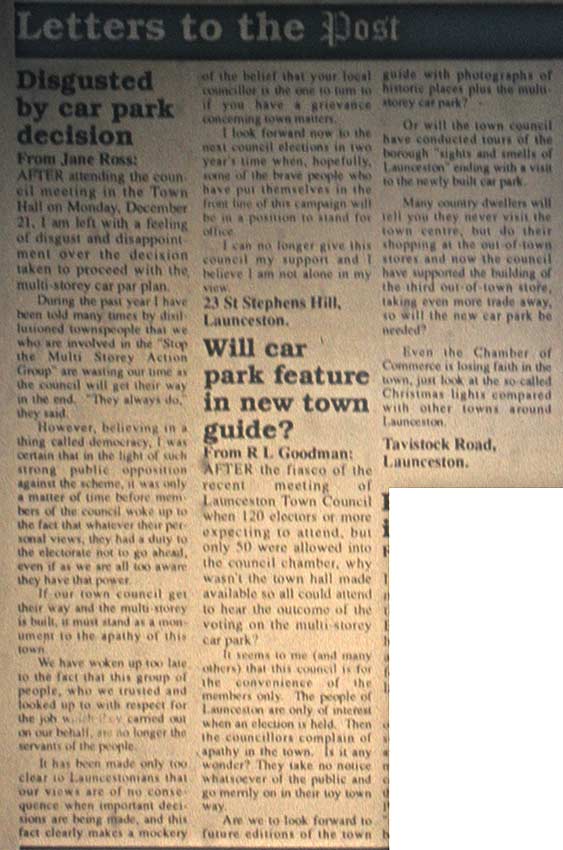
The fallout from the councils decision soon occurred when the annual Christmas visit of the mayor to the Royal Mail sorting office at Pennygillam was cancelled. The mayor Derek Bradshaw was told that many postmen were unhappy with his visit, due to his support for the multi-storey. Derek Bradshaw said he was ‘sad and disappointed’ that because of personal issues, the mayor was not welcome on an official visit. The situation was described as ‘deplorable’ by fellow councillor and car park supporter Alan Buckingham, who did not want to see Mayoral duties diminished. “I would like council members to take time off between now and the full council meeting and see how we feel about the implications of someone saying you can come if you want, but you will not be welcome,” said Mr. Buckingham. Royal Mail area manager told ‘The Cornish and Devon Post’ that Mr. Bradshaw had been invited to the sorting office. He added “He didn’t come although the invitation was there.” “We’re aware that there is an issue in the town at the moment and our staff are local people who have their own opinions about the car park, We wouldn’t want them not to have an opinion on an important local issue, but they would have acted properly if the mayor had visited” he said.
With 1992 nearing its end, the question of the multi-storey took another twist when North Cornwall M.P. Paul Tyler, wrote to Bill Grigg, chairman of the district council’s finance committee, suggesting more modest spending elsewhere in the town may be more appropriate in the light of substantial cuts in the authority’s budget for 1993-94. He also hinted at the impact of the development of the Old Sheep Market site on the authority’s own car parking revenue. “Clearly there are difficult decisions to be made, and we all appreciate the impossible task you and your colleagues have in deciding priorities,” he wrote. “For one possible economy, however, there is obviously widespread support. I do not, as M.P. Have a direct role in the development control process, and happily leave this aspect of planning to your elected members. Nevertheless, the large number of residents of Launceston and other parts of the district who clearly regard the construction of a new multi-storey car park in the town as unsuitable for investment of your poll tax payer’s money is a factor which none of us should ignore. No doubt, in the present financial climate, you will also consider the impact on your own car parking revenue.” In the meantime, he said, a more modest investment in improved lighting and pedestrian access to the district council’s Race Hill car parks was far more urgent. He added; “I am sure that you would have widespread support for any move to transfer funds from the multi-storey commitment for this purpose, while at the same time achieving major economies.”
1993, the referendum and construction
At the February 15th council meeting, the councillors voted 8–6 in favour of signing the legally binding contract for the work to go ahead. This despite that a local poll had been organised for Launceston’s 6,00 0 electors for March 4th. The decision was unexpected and left opponents astounded and prompted angry outbursts and calls for councillor’s resignations. And it came despite pleas from some members that the council should wait for the outcome of the poll, and each read the 50–page contact before it was signed on their behalf. Town clerk Philip Freestone told the meeting that the authority resolved in December to erect the car park and was now in a proper position to commit itself to having the £518,595 structure built. The contract had arrived at the council offices on that very Monday morning and was ready for signing, although there was no mention of it on the evening’s agenda. Councillor Barry Jordan claimed it would be ‘undemocratic’ to sign the document without every member first reading it. “I have never had a contract signed in my name which I have not been able to read through,” he said. “It seems rather rushed if the contract has only been received that day. If it had been received last week and every member of the council had been told, I would have gone to see it,” he continued. The recorded vote — with eight members in favour, six opposed, and one abstention — sent shock waves through the public gallery prompting opponents to declare their ‘disgust and disgrace’ at the authority’s actions. Nigel Bowman said “the council was a disgrace to the country and a disgrace to Launceston” and he threatened to sell his Launceston Steam Railway to a supermarket chain. Councillor John Coles later told ‘The Cornish and Devon Post’ after the meeting that he was ‘shaken’ by the vote, which he described as a pre-emptive strike against public opinion. He was ‘incredulous’ that his fellow members were prepared to sign a 50–page document, only seen by two councillors by Monday’s meeting without reading through it or awaiting the outcome of the poll. He then said he would be asking the contractors, Dudley Coles Limited to ‘act honourably’ and not sign its contract with the town council until after the poll on March 4th. Mr. Coles stressed the need for electors to vote next month to show the town council that it was acting ‘undemocratically.’ The town council issued a press statement after the meeting, reaffirming its support for the car park plan:
‘The present site was ‘woefully inadequate’ and invariably full at busy times of the day and most evening when it catered for people using the Town Hall and Conservative Club, five nearby restaurants and takeaways, Westgate Inn, the Ambulance Hall, and the historic Castle, which attracts about 20,000 visitors a year. The Dockey car park is close to the direct route from the A30 and the first, and probably the only one to be discovered by visitors approaching for Pennygillam roundabout. The statement explained that the scheme provided for 150 spaces on three levels, the top deck being less than two feet above Westgate Street at its present entrance. The lower levels are to be excavated below existing ground, with a single exit opening on to the Dockey adjacent to the Town Hall, which the council believes will considerably improve traffic conditions in that part of the town. The scheme also includes new public toilets, boasting full facilities for disabled people. North Cornwall district council has agreed to provide a capital grant of £200,00 towards the project, and the town council will provide £100,00 from its own resources. The remainder will be probably be raised through Loan Consent, with repayments of not more than £35,000 per annum over 25 years. The income from the new car park’s first full operating year is estimated between £100,00 and £120,00, as compared to the £50,000 per annum it is currently making with 70 spaces. The council believes the profitability of the car park is ‘bound to rise,’ and that will be set against the future precept figure for the town. The statement concluded, the new car park is well considered and will benefit the town both economically and practically. The council, in winning the appeal for the planning and further satisfying the district auditor on the financial implications, have shown they honestly are working for the future of Launceston.
The ill feeling now began to boil over, with members of the town council and their families being targeting with a series of abusive letters and telephone calls. Town clerk and secretary, Philp Freestone and Margaret Sanderson, had received abusive calls and visits. Councillor Ruth Sleeman told the above meeting that she had received three ‘rather nasty letters’ and her twin sister had been verbally attacked in a case of mistaken identities. She said “I felt very ashamed to think that people are sending out these letters. I have been loyal to this town since 1976.” Councillors Arthur Wills and John Barnes both confirmed that they also had received threatening mail, which they had passed onto the Police. Fellow councillor John Coles disassociated himself and other action group members from the work of what he hoped was a ‘small fringe element of extremists.’ He said “none of us would condone the sort of personal attacks that members of this council and their families are receiving.”
Meanwhile, solicitors acting for the No Multi-Storey Group made an application to the High Court for a judicial review of the council’s decision to seal contracts for the building to go ahead. They were also seeking an injunction restraining any, or further work from being carried out in connection with the car park. The letter ended: ‘It may be that under circumstances councillors who voted in favour of the resolution will wish to take independent advice on their own position and the possibility of an order for damages or a surcharge being made against them personally if the council acted ultra vires. We should add that the barrister we have instructed tells us that in his opinion it did.”
After an unsuccessful attempt to move an amendment calling on the council to delay sealing contracts until after the poll, councillor Barry Jordan, supported by councillors John Coles, Ruth Sleeman, Sam Bradshaw, Jim Hughes, and Kevin Wadland, had written to the mayor asking for a special meeting of the town council to be called within seven days. The resolution to go before that meeting read:
‘That the Launceston town council rescinds the decision of February 15th, 1993 that stated documents should be sealed.’
Mayor Derek Bradshaw would not comment on the latest moves by the opponents but said that the council was seeking advice on the last paragraph of the opponents letter.
In the meantime a night–time ride on Launceston’s Steam Railway raised £524.08 for the No Multi–Storey Group, who had opened a campaign shop in Westgate Street (below left). A sponsored walk was also organised to help raise funds for the group.
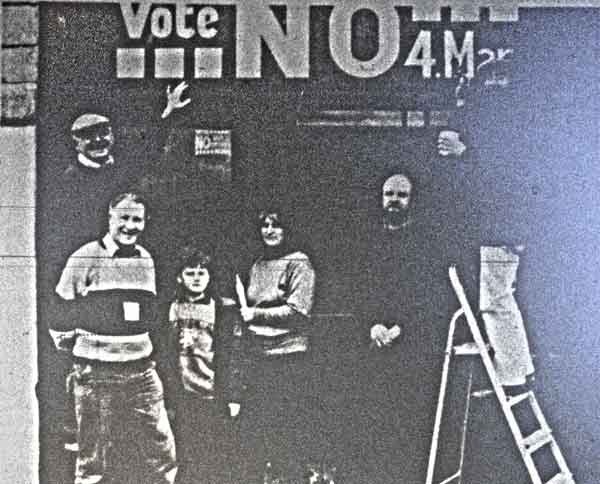
Tensions mounted in the lead up to the historic referendum, with the opponents releasing their own artist’s impression of the scheme (above right seen from the Dockey). Councillor, John Coles, said “the town council produced an artist’s impression, and a description of the the car park which appears to have misled many. They have said that it will be less than two feet higher than Westgate Street at the entrance, with the lower decks excavated below present ground level. However, we have been pointing out to the many visitors at our Westgate Street campaign office that it is really a very large structure indeed, and it will dominate this historic corner of the town forever.” “The artist’s impression released by the ‘No Multi-Storey Group’ had been drawn based on the architect’s designs, and showed how the viewpoint from the Castle gate had been ignored in the town council’s public presentation. The car park would be almost as high as the ridge of the Guildhall roof, and would remove forever the view of Westgate Street,” he said.
Adrian Hawkins, president of the town’s Chamber of Trade and a supported of the scheme, said that many residents would vote against the town council, rather that on the car park issue. “If everyone had to vote and there was a category for ‘I don’t give two hoots’, I think that is what most people would vote,” he said adding that “I think the car park is a good idea, but the way the town council has gone about it is diabolical. I hope that everyone will go and vote because it is the fairest way of doing it.”
The poll took place on March 4th, at St. Thomas Church Hall and Launceston Town Hall with electors from Launceston’s north and south wards being eligible to vote. The polling stations were open from 4 p.m. Until 9 p.m. With the count taking place at the Guildhall immediately afterwards. The result was a massive thumbs down for the scheme, with 2,820 against and just 156 for representing a majority of 18 to one. 57.7% of those eligible voted. After the polls closed long-standing opponent Nigel Bowman told the ‘Trelawney’ singing crowd: “A year ago, Launceston’s oldest and probably most respected councillor, Taffy Hughes, told the council that 95% of the town were against the car park. He was right, exactly 95% of the vote tonight is against it,” Fellow opponent and town councillor John Coles also expressed his delight at the result, and said he didn’t see how the council could now proceed with the scheme. He understood that although the contract had been signed on behalf of the town council, it hadn’t been signed by the contractors, Dudley Coles Limited, and exchanged. The council, he said, should now tear up the contract and proceed no further. He concluded that the No Multi-Storey group would continue with the legal action, saying that the advice was sound and that they had an excellent case to prove not only that the council acted beyond its powers in the way the contract was signed, but also that the poll result must be acted upon. The action group called another parish meeting under the Local Government Act, to be held at the Town Hall on Wednesday March 13th, in which had two resolutions on the agenda. The first was for the council to rescind contract, and the second was for the entire council to resign.
However, the mayor, Derek Bradshaw, claimed that the result was no different to what he expected, stating that 45% of those that did not vote were not bothered about the car park. The council, he said, had maintained throughout that the result of the poll was not legally binding, and the contractors had been told they can start work when they were ready. He said: “The town council has to take into account the views of all people who rely on the town — shop keepers, voters, tourists, county council and district council views.” “We are still a market town with a regional pull of visitors and travellers, and if we don’t provide the facility they will not come here. If this doesn’t proceed then within five to ten years you would have a totally dead town centre,” he said prophetically.
The aftermath of the February 15th meeting was still being felt almost a month later, with various allegations being made as to the honesty and reputations of various members of the council. In a move suggested by councillor Alan Buckingham, the members were informed to lodge any details with the town clerk as evidence in cases of future legal action. Mr. Buckingham said: “it may be that attitudes will be different, I don’t know. I think we should protect our personal reputations and the reputation of this council.” He stressed that he had not been prompted to suggest the move because he was nervous, but because he wanted councillors to be reassured of their safety. Fellow member Monty Brown confirmed that threats and allegations of corruption had been made at the previous months meeting. However he felt that the council should ‘move on and let go.’ He said “I don’t like what has happened, but I don’t see that any useful purpose would be served by locking someone away.”
At the next council meeting, a further attempt to stop the plans for the scheme was made. Councillor John Coles asked that all action in connection with the car park should be suspended until the result of any legal action was known. Mayor Derek Bradshaw ruled the proposal out of order and forbade any further discussion as the item was not on the agenda. This resulted in the 60 people in the public gallery jeering loudly “out, out,out,” and “resign.” The mayor was forced to adjourn the meeting for a short while before calm was restored. Addressing the mayor, councillor Coles said “I think I represent the 2,820 who voted against the car park, and you represent the 156 who voted in favour. I believe this council has been persistently wrong in discussing the car park in committee, or as I like to put it, in secret.” Mr. Coles said he believed the ‘No group’ had a good case, but was prepared to offer an olive branch to the council. He added; “that is in view of the result of the poll, the council suspend all action in connection with the car park until the full result of any judicial action is known.” Councillor Coles said he would like the vote to be taken in form of a written ballot, and issued each member with the written proposition. But the mayor refused to accept the resolution in that form. It was then that councillor Barry Jordan asked if the car park contract had been signed. However, town clerk Philip Freestone could not give a positive answer and replied: “the documents are in the hands of our advisers, and because the matter has gone to the High Court, I cannot discuss the matter.”
At the March 13th meeting, which was attended by over 500 angry electors, the call for the council’s mass resignation was again made. Jeering electors said the council had ignored the recent referendum, and claimed that councillors were out of touch with the public and did ‘not measure up to the job of governing Launceston.’ They called for the election of 15 new councillors to give the town a fresh start. The call was led by councillor John Coles who said “the only way forward is for this council to resign — the whole council.” His motion calling for the council’s mass resignation was overwhelmingly carried by the meeting with only two votes, both from town councillors, against. The meeting, chaired by mayor Derek Bradshaw, also demanded that the council rescind the car park contract with the builders, Dudley Coles. Wilfred Cocks urged the eight pro-car park councillors to listen to the people and change their minds. This, he said, would bring ‘joy’ to residents and ‘relief’ to councillors. It would help restore credibility and allow them to walk through the town square with their heads held high. Mr. Cocks warned the the ‘No multi-Storey Group’ would continue with their legal action and would see it through to the end if the council refused to back down. “If they continue to dig their heels in, they face a very difficult time, a time of anxiety, in which there may be financial and legal implications. They have come to the critical hour of decision. This is now serious and we are serious. We urge them to decide that this must stop,” he said.
This meeting caused more uproar through a whispered comment mayor Derek Bradshaw made to the town clerk Philip Freestone. With the saga now taking on interest from the wider media, the BBC were in attendance and one of their ultra-sensitive microphones picked up the whisper, where the mayor was heard to say “one day Coles….I shall take him in little pieces.” But when Launceston resident Marilyn Elliottt interrupted the meeting to accuse Mr. Bradshaw of ‘making a threat,’ he publicly denied saying anything about Mr. Coles. Mrs. Elliott, he told the packed meeting, must have misheard him, and he later repeated that she was mistaken. But after the comment was subsequently broadcast on the following evenings ‘Spotlight’ programme, Derek Bradshaw conceded that Mrs. Elliott’s assertions were correct and wrote a letter of apology to her. It read: “I can confirm that you did not mishear me and I therefore apologise to you for comments made. May I also say that no threat was implied or intended.” But Marilyn Elliott was not satisfied with his letter, claiming the mayor made no apology for trying to ‘discredit’ her. The events at the parish meeting, she said, proved that Mr. Bradshaw fully intended to protect his reputation at her expense. In a letter to the mayor, she said: “As you are well aware it takes a considerable time, in any walk of life, to build up a good reputation for oneself but just a few seconds to spoil it. You trued to blot my character in front of a packed meeting.” She concluded she would like a public apology and that the annual town council meeting on April 22nd, would give the ideal opportunity to do so. However, Mr. Bradshaw denied that he had tried to discredit her and he felt his letter was apology enough for the incident.
The annual town council meeting was held in a hostile atmosphere as more than 300 people packed the Town Hall. There were complaints of the slow start made especially with the length of reports that officials claimed had to be read before public resolutions could be considered. Town clerk Philip Freestone’s annual report of the parish council then caused furore resulting in accusations of ‘bias’ from the floor. People were outraged by Mr. Freestones’s statement that the council had maintained a dignified attitude throughout the ongoing car park row, despite personal abuse suffered by many members and their families. There had been a great deal of ‘Ill–informed comment’ from those opposed to the controversial plan, he added. The annual report continued: “It is right that elected councillors may be criticised for making decisions not to the liking of the people. But they are elected councillors and must make decisions which they feel would be to the benefit of the town. The way to change is through the ballot box, and not through personal abuse.” Councillor John Coles was incensed by his statement, saying people would no doubt accept it if it had been written ‘in a less biased way.’ He dismissed concerns of mayor Derek Bradshaw that the meeting was ‘drifting out of control’ claiming that the problem had arisen because the council’s annual report was ‘insulting’ to the electors. “I am sure the meeting would accept an unbiased report from the chair,” he added. “The clerk’s report should be completely anodyne, if I may say so.” “It has just been said that the way to change things is through the ballot box, but that was done in March when 2,820 to 150 and you have chosen to ignore it.” Parishioners at the meeting later voted overwhelmingly to disregard Mr. Freestone’s report. The town councillors were visibly shaken when the angry residents gave an overwhelming show of hands in favour of a proposition for contracts for the car park scheme to be rescinded, and for the councillors to resign en bloc. After a roaring speech made by councillor John Coles in which he demanded the resignations, the hall erupted with clapping hands, stamping feet and near-deafening cries of “Out, Out, Out.” Parishioners supported a subsequent call for the town council to abide, as far as practicable, by resolutions passed at parish meetings. Mayor Derek Bradshaw told the hostile crowd that the propositions couldn’t be voted upon that evening, but he stressed he was not ‘dodging the issue.’ He would undertake however, to include the matter on the agenda on the next meeting but one, of the council. Proceedings later became even more bogged down as an almost private war was waged between Mr. Coles and Mr. Bradshaw over whether contracts for the building of the car park had been exchanged with the contractors. Mr. Bradshaw and town clerk Philip Freestone both maintained that contracts ‘existed’ between the two parties, but refused to elaborate any further. The meeting went on for four hours at at the end ‘No Multi-Storey Group’ member Wilfred Cocks, appealed to senior councillors to rethink their decision to back so wholeheartedly the controversial scheme.
Even before the High Court appeal could be heard, on Monday May 24th, the council closed the Old Sheep Market car park as the contractors moved in. Residents and opponents were horrified to find the cap park closed, and many braved the rain to hold a brief rally to register their protest. District councillor Yvonne Horn said “I think it is appalling — democracy, as far as I am concerned, has gone out of the window. The car park is public property, it is public money; I think it is deplorable. It really makes you want to give up — you think ‘what am I councillor for?” “The only good thing that will come out of it is that in two years time you are going to have a new town council.” The town council’s decision to press ahead with the contractor’s official starting date, came despite the discovery that listed building consent was required before the wall flanking the Town Hall could be demolished. North Cornwall district council’s planning director said “the onus was on the applicants or developers to obtain all necessary consents, ideally before starting the work, but it didn’t affect the rest of the car park.” The new mayor, John Barnes, (at 32, Launceston’s youngest ever mayor) confirmed that the authority had been told by its legal advisers that it didn’t have to wait for the High Court hearing to start work. He said “a resolution was passed by nine to six (with one abstention) on Friday, May 21st, to start the work, and once the contract was signed (by himself and deputy mayor Clive Horton) after the meeting, the starting date of May 24th was added.”
Meanwhile, a special meeting of the council was convened for Friday, May 28th, to discuss a resolution by councillors Barry Jordan and Colin Warne to suspend the town clerk, Philip Freestone, pending inquiries into his actions regarding the car park. A third resolution was added to the agenda concerning councillor Barry Jordan’s language and behaviour towards Philip Freestone. This was due to a heated debate at the previous Friday’s meeting when councillor John Coles asked to see a fax from the district council regarding the listed building requirement, which, he said, had been sent to the town council’s office. Mayor John Barnes initially claimed that they no longer had a copy of the fax, as Philip Freestone had given it to the authority’s architects, Jonathan Ball Practice. This statement outraged councillor Barry Jordan who accused Mr. Freestone of ‘over-stepping his authority.’ “Unless all the information is on hand, we cannot make a decision on this tonight,” declared an irate Mr. Jordan. “Philip Freestone has given the relevant piece of information away; I have accused him of not giving the full facts to this.”Further angry exchanges took place, until Philip Freestone said he had a copy of the fax, which confirmed that listed building consent would be needed before the wall at the rear of the Town Hall could be demolished.
At the same time Chief Inspector John Isaac, of Launceston Police, urged everyone involved in the car park wrangle not to ‘overstep the mark.’ “We are concerned that now action is being taken at the site, that something is going to happen. I am urging all involved not to break the law and to involve the police. If someone breached the peace or causes damage to the site, we can and have to act,” he said, adding, “the last thing we want is some well intending person to do something silly and end up being before a court.”
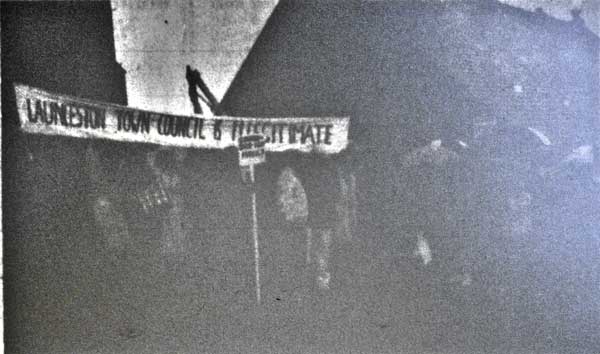
The High Court hearing was duly heard the first week of June with Mr. Justice Macpherson dismissing the ‘No Multi-Storey Group’s’ application for leave to bring a judicial review in regards to the car park scheme. In giving his decision Mr. Justice Macpherson said he could see nothing illegal, irregular or perverse in the council’s plans, which were passed by a narrow eight to five vote. Legal moves by the group, he said, would be ‘doomed to failure.’ The judge described the proposal to build the car park as a ‘very hot issue’ in the town, and said it was very unpopular with a lot of local people. “I fully understand their feelings, but it is not for me to side one way or the other,” he continued. The judge said it might be possible to seek and injunction to stop the car park going ahead in other court proceedings. This was a matter for the action group to discuss with their legal advisers, and a matter for Launceston voters. “If voters disapprove of the way those in office have regulated their lives, they can throw them out in the future,” he added. He refused an application that the group should pay the council’s legal costs as it would only exacerbate bad feeling in the town. Each side were ordered to pay their own costs.
Leading opponent John Coles said he was ‘sad and angry’ at the outcome of the High Court hearing, which, he conceded, had been expected. “The circumstances had changed so significantly that the case had changed. I certainly felt very cheated that the town council’s solicitor would not allow us the adjournment we requested. We tried to be fair to them, but I think they were very unreasonable to us in the circumstances,” he said. “Substantial new evidence was coming to light day by day, and rejected claims that the action group was now fighting for a lost cause. We’re not flogging a dead horse, but we may well be changing horses,” he added, cryptically. “It is inevitable now that the fight is going to take a different direction, we are not going to give up until it is built and there are cars parked there.”
Launceston mayor John Barnes welcomed the decision and said the council would now press ahead with the construction. “Once the structure was built, people would hopefully see what a benefit it would be for the town’s future. We will try and work to establish better feeling in the community. I think it will take time, but with time and patience I think we can resolve a lot of the bad feeling in the town,” he said. “I know there will be people on both sides who are going to feel very aggrieved, and those feelings may not go overnight, but once the car park is built, a lot of people will see what a benefit it is for the town’s future. That is what I am looking forward to,” he added. (Below two pictures of the Sheep Market Car Park courtesy of Peter Gilbert).
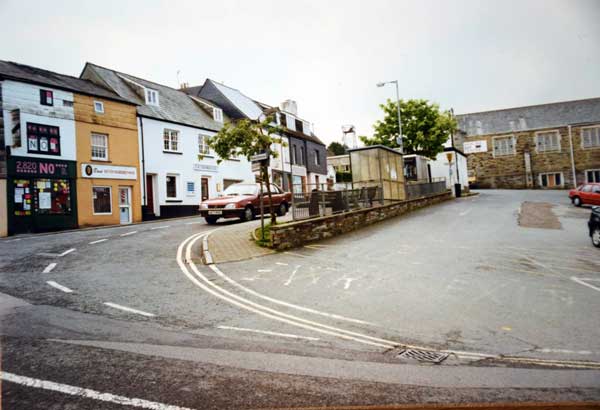
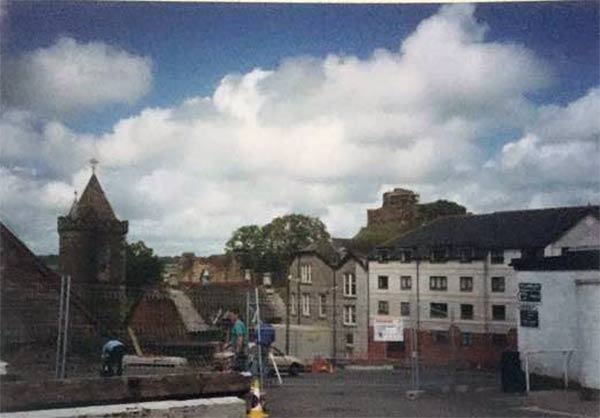
Although the opposition continued their campaign, after that High Court defeat, there was very little that could in reality be done (above two images of the site closed down in preparation for construction. Photo’s courtesy of Mark Knight). A couple of weeks after the construction began, Wilfred Cocks and Hal Lee (seen below left being escorted off the site)went onto the site to advise the foreman that excavation work should be monitored by a representative from Cornwall County Council’s archaeological unit. But they told ‘The Cornish and Devon Post’ that the foreman was immediately antagonistic, and rejected their attempts at conversation. “It is the first time since either of us had set foot on the site since work began” said Wilfred Cocks. “It was a shock to the system — it was an immediate response of aggression and it was quite appalling. The principle involved is dreadful,” he continued. Hal Lee, a retired RSPCA inspector, cut his hand as he tried to steady himself, and needed hospital treatment. Dudley Coles managing director Douglas Elliott confirmed that the company had received a complaint, saying that “the contract has aroused a fair amount of public debate, but we are purely the building contractor, employed to do a job, and we are not taking any sides in the debate.” Although the Police were contacted at the time no official complaint was made.
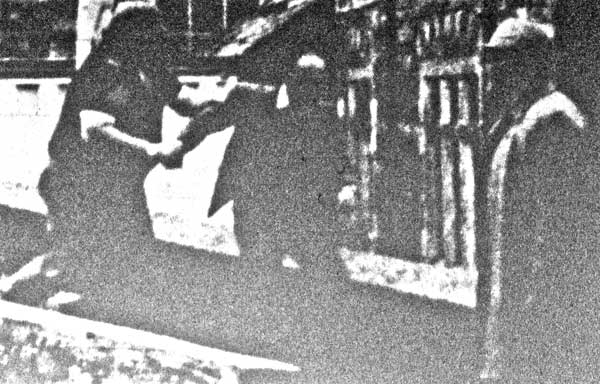
The animosity continued on both sides with anonymous telephone calls being made to councillors that supported the scheme. Councillor Rob Tremain found the front of his property dubbed with bright yellow paint. Wilfred Cock sent a letter on behalf of the ‘No Multi-Storey Group’ stating that the had no knowledge of the matter, nor did they support such action, or any other form of physical intimidation.
That years civic parade and service failed to heal the rift, with abuse being hurled at town councillors and members of the public as they left the Sunday service at St. Mary’s Church and two eggs were thrown towards the procession. Such was the feeling that several organisations did not attend, some through prior commitments, but others boycotted the event as a protest to the council’s decision to press ahead with the multi-storey. Mayor John Barnes described the service as ‘very poignant,’ but said he was disappointed that some local organisations were unable to attend. He said “one or two members of a local organisation, whose leader would not allow them to partake went with another group. I am disappointed that some of the leadership would not allow them to go. Some members of the opposition were in the church, which you have to give them credit for. But I am disgusted with some of the activities of people outside the church; some people turned their backs, okay, but verbal abuse was thrown at members of the public and the council for attending the church service, which I find abhorrent.” Car park opponent Wilfred Cocks said the ‘No Multi-Storey Group’ actively discourage this kind of behaviour.
Council meetings continued to be a hot bed of controversy with the July 8th, meeting of the finance committee having to be adjourned after councillors were heckled by the 40 strong gathering in the public gallery.
In an unexpected move, the ‘No Multi-Storey Group’ produced its own plans of how they believed the Sheep Market site should look later in the July (below).
Wilfred Cocks persuaded architect, Margaret Withers of Warbstow to provide a design which utilised the giant hole and concrete structures already in place at that time. “We actually regarded the hole as an asset to the town,” said councillor John Coles. “It has given us the opportunity to virtually hide a ground level car park under cantilevered promenades. The space becomes a civic square, reflecting the Victorian and Edwardian character of the area, and providing superb vistas of the Castle to attract the tourist. He said. But mayor John Barnes, described the plan as ‘mischievous’ and accused the action group of ‘misleading’ people, and wasting their money. The council, he said, was now maintaining the listed wall at the back of the Town Hall, but applying for permission to demolish the Mortuary. If the Mortuary had to be retained, he said, amended plans would have to be drawn up, causing extra expense to Launceston’s rate payers. Mr. Barnes said: “It is an absolute waste of people’s money and time, and would create an ulcer on the landscape. The gloves are off now because we have proved them wrong on three counts — architecturally, financially, and legally — and they are now just using delaying tactics and misleading the general public,”
In another twist to the saga, North Cornwall planners threw out the plans to demolish the old Mortuary, voting nine to eight in refusing the application. The town council were seeking listed building consent to demolish the wartime building, and for permission to re-position the north wets elevation of the three tier car park to retain the listed boundary wall. Chief planning officer Tony Philp claimed the Mortuary made no special architectural contribution to the area, and recommended that consent should be given for its demolition. Launceston district councillor, Yvonne Horn was vociferous that it should be retained, and all possible alternatives investigated before demolition is considered. She said “ We don’t want to see this building demolished. It doesn’t matter if it is the Mortuary, or the wall, or the Castle, it is our history.” She continued “from the outside there is nothing historic about it, but it was built because of the Town Hall’s use during World War One as a hospital.” She was supported by Wadebridge councillor Colin Brewer, who said the town council should not build the car park if they couldn’t do so without demolishing the Mortuary. But Launceston district councillor David Viggers argued that the building was not worthy of retention, and added: “If it was not the Mortuary, it would be another wall or something else they could cling to. The majority of people in the town are resigned to the fact that there us going to be a multi-storey car park in the town, and there are just a few who are doing this.” “This thing is festering in Launceston all the time; those of us who live in Launceston know what it is like. The quicker this issue is resolved, the better for everyone concerned,” he said.
By the end of September it was revealed that the scheme was £46,000 over budget and 12 weeks behind schedule. In a statement from the town clerk, Philip Freestone, it was claimed that most of the additional costs could have been avoided but for the actions of the ‘No Multi-Storey Group,’ but councillors agreed that the claim should be omitted from the report before it was adopted. The planning inquiry cost a total of £22,230, which members argued had been brought about as a result of the authority’s decision to appeal against North Cornwall district council’s refusal of the plan, and not ‘delaying tactics’ by the action group; £11,380 had been spent on the amended plans; £1,00 on the dispute over a right of way over the car park site; £7,684 on the High Court action, and £3,500 on the district auditor. Members were also told it would cost £2,000 for every week that the contract overran.
At the same time an extraordinary meeting boiled over into another heated debate, this time over allegations that correspondence was being kept secret from certain councillors (below).
It was becoming more and more difficult to administer town council meetings and the meeting held on Monday September 20th, proved no different when the council met to discuss the options open after the North Cornwall district council planners rejection of the application to demolish the 79 year old Mortuary. The option chosen was to ask North Cornwall for the go-ahead to complete the construction of the car park without touching the wall or mortuary. The cost of this option was approximately £42,00, set against the five other options that would have cost up to £193,000. One of the five choices was to halt the work for four months, at an estimated extra cost of £125,000. Councillor Coles declared that of the six options, one would be a criminal offence and the other five would be very expensive. He later said that the cost of the chosen option, plus the cost of the appeal to Environment Secretary, John Gummer, against the planner’s refusal of consent, and the original bills would total around £600,000. Mr. Coles said at the meeting that the town council was giving instructions to progress work which still could not be completed without further planning consents. He stated that he would try to make sure that ‘not a penny of extra expense incurred by this council is paid by the ratepayers of this town.’ He called for the council to cease committing further expenditure on planning and legal expenses – matters which should have been in place before building began. To loud cheers from a packed Guildhall, he again called for the council to resign. Opponents of the car park refused to budge when the council decided to go into closed session to discuss legal aspects of the options, before resuming the open meeting. After ten minutes, the councillors withdrew to another room. Tempers often flared with claims, counter claims, and accusations flying across the room, under the watchful eye of two policemen. At one point, councillor Barry Jordan called for a truce over the issue, which had reached ‘the end of the road.’ “It is going to be built whether we like it or not. At the moment, it is costing us all a great deal of money. Why not get it built so that it is earning money. We should start working together to benefit Launceston and stop ripping it to pieces,” he said. Town Clerk, Philip Freestone referred to the previous row about a fax and said claims made had been incorrect. He did not know of the existence of the fax and he likened the treatment by opponent’s to that of ‘a lynching party.’ He added; “This is another example of the malicious nature of the opposition to denigrate the action of myself, acting as a proper officer of the council.” During the 15 minute question time for the public, some present claimed it was ‘a farce’ because there were questions, but no answers. But mayor, John Barnes, insisted that the council had decided to build the car park with proper permission and had given the necessary authority. To claims that he had not answered, he retorted: “I have answered in the way I feel fit.”
At the same meeting it was agreed to temporary open the Town Hall toilets between 9 am and 4:30 pm to replace those in the Old Sheep Market car park that had been demolished.
The ‘No Multi-Storey Group’ were given a fillip in the October, when North Cornwall district council passed their own application to crown the car park with a scenic civic square. The idea of the scheme is that 46 parking spaces would be provided at the lower level, using work already done. Cantilevered over part of this would be the civic scenic square, to be called The Prom and Chestnut Tree Walk. This area would have a bandstand, shelters, seating and planting, and would link with a building which would include public toilets. The scheme was opposed by the town council. Councillor Neil Burden said giving approval would mean the loss of more and more car parking spaces. He said; “They needed to cater for people to park near the town centre. You should look at it from a practical point of view. It is not a sensible use of a car parking area.” Councillor Graham Facks-Martin said: “I can’t see any planning reason to refuse. It is pleasant enough and I very much doubt that it will ever actually be built.” Wilfred Cocks said after declaring it a moral victory, that the group would welcome talks with the town council and contractors to work out an acceptable way ahead. “The battle has gone on far too long and should be halted forthwith,” he said.
On Wednesday, October 27th, the planners met at Camelford to decide on the amended plan of the town council, which was seeking the go ahead for repositioning and reducing the size of the car park in order to keep the listed stone boundary wall and former mortuary building. At the packed meeting Steve Atkinson, the planning officer, said the net loss of parking spaces would be eight, taking the total down from 144 to 136. There were more than 100 letters of objection to the changed plan, including one which said there was considerable doubt over the funding of the project, which depended on the release of £200,00 for the district council. Councillor Brenda Parsons said that the work was done without proper consent and that should really be the concern of everyone. “ I find the whole thing absolutely shocking, Words fail do me. If everything has been done by the book, why is there so much hassle and why are they coming back with amended plans and wanting listed building consent?” She asked. She claimed that if an individual had acted in the manner of the town council, they would have been given hell. Councillor Graham Facks-Martin said there were no grounds for refusing. “The car park is nearly built and it is a sad sight to see the town tearing itself to pieces.” He referred to the vote against the wishes of the people and said there should have been a compromise at the time. “It could be suggested that the town council did not intend to take any notice of the referendum whatever the votes expressed in it.” Councillor Yvonne Horne said they had refused the mortuary demolition application saying “if anybody changes their, it has been a complete waste of time.” All the time councillors were being threatened with costs, legal action, and being surcharged if they turned it down. “If you refused it all along, how can you turn round and say it can go ahead now?” “Surely planning is about being consistent?” She asked. Bill Grigg said he deplored the decision of the Environment Secretary to grant planning go-ahead on appeal to build the car park. Pleas came to the council to save the wall and mortuary. “Having done so, it seems to me quite unreasonable not to agree the amendments which will enable the mortuary to be retained. It seems obvious to me that the object is to further embarrass the town council,” he said. Councillor John Lugg said he has voted against in the past. “Many of us would want to vote with out hearts because our hearts would say vote with the people of Launceston. But, the truth is that for two years we have had a bad time of it. Many of us have stood for what we believed in and been harassed for it,” he said, adding “If they voted against the plan, they would be taking a risk.” The subsequent vote was in favour of the amended plan and the application was granted. This caused an uproar in the public gallery. The incensed opponents of the scheme vented their anger and frustration on the committee members, who were accused of betraying the town and the democratic process. Town councillor John Coles told them they had sold the town down the river. He said he was angered by the smiling faces of planners. “I can be silenced no longer. I have stood by for two years and seen democracy totally and absolutely abused.” He shouted, Asked to leave, he shouted “You will have to remove me,” Wilfred Cocks tore up some of the pages of the agenda, and Nigel Bowman shouted “This is juts the beginning. Democracy in North Cornwall starts tonight.” ‘We have feelings…’ said another protester, and a fourth said; “If this is democracy, God help us.” It was then that the planning committee chairman, Harvey Lander pleaded with the opponents to leave quietly so that the committee could deal with other matters but half of the 40 or so opponents stayed put and refused. Councillor Lander then announced that he was adjourning the meeting until the public gallery was cleared. A policeman arrived later, but the anger had by then subsided somewhat and there were no arrests.
The following week the ‘No Multi-Storey Group’ finally admitted defeat with long time campaigner Wilfred Cocks saying “In all battles, there comes a time when you have to realise your number is up. It is better to do one’s swansong gracefully rather that linger.” “Clearly, we are extremely disappointed not just that the amended plan has been approved, but the way in which district councillors were threatened with surcharge if it was declined.” “We hope the Ombudsman will make public criticism of the Planning Officer’s actions. As talk of the controversy ‘splitting the town,’ I see it as an event that has brought the vast majority together in a unique manifestation of public concern. We have had immense support from the areas around Launceston and from faraway places. It has cost a great deal in time and money, and we still need £2,500 to clear loans made by public-spirited well -wishers., But, it has been worth it. We all have the satisfaction of having stood up for what we believe to be right. The local councillors who have ignored this united outpouring face the likelihood of having to live with a financial and environmental fiasco. We do not envy them.”
The multi-storey was finally completed in 1994 and now stands testament to a struggle that divided the town. Time is said to be a great healer, but for many on both sides the argument, some twenty years after the saga, the whole memory is still quite raw. The ramifications in the council chamber echoed on for some time, with many that served at that momentous time no longer in public service. Many residents to this day, refuse to use the car park, preferring to use, ironically the resurfaced cattle market car park. The car park is far from the burden envisaged by many and it is budgeted to make a £51,457 profit for the 2014/15 year. The town centre has duly been pedestrianised, again causing some controversy along the way. It is a matter of opinion as to whether the aesthetics of structure and its ‘landscaping’ are pleasing to see and if indeed they sit well in their environment. But for the casual observer not knowing the trouble this one structure brought to a quiet Cornish town, its quite simply a place to park the car.
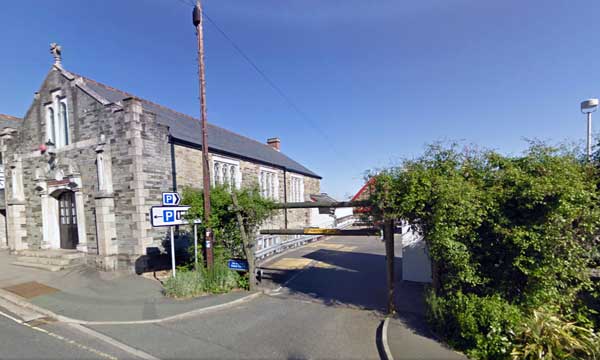

Visits: 345

